N • Common ground

C
Sap season

S • Celebrating 25 years
“Syracuse University needs to stop parading diversity, equity and inclusion — needs to stop parading people of color — if they are not going to actually commit to the change that they say they want to see.” jordan beasley, president of bsu “It don’t feel the same way as it did with #NotAgainSU... but it’s even worse now.” jordan Pierre, grad student
Eroding education
The state of African American Studies at Syracuse University
“ How can I tell another Black kid to come to this school and they’re not teaching us about our Black history? It just is backwards.” john bol ajak, former su basketball player “Speaking of killing a department, that is a recipe.” s. n. sangmpam, aas professor
The songs and chants of the Civil Rights Movement echoed through the quiet, empty corridors of the second floor of Syracuse University’s Sims Hall as Herbert G. Ruffin II, associate professor of African American Studies, taught a handful of students about Rev. Dr. Martin Luther King Jr.
Nearly 60 years ago, King spoke at Sims Hall about “inequities in American education.” In 1969, four years after his speech, more than 100 Black students demonstrated on the front steps of the university’s administration building, demanding SU address the needs of Black students. The protest led to the 1971 creation of the AAS program and its Martin Luther King, Jr. Memorial Library, and in 1979, AAS was officially established as a department in the College of Arts & Sciences.
But on Jan. 12, 2024 — the last business day before spring semester classes started — AAS faculty and staff
received an email notifying them that their department would have no chair for this semester. The decision was made after no agreement was reached for an interim chair appointment of Ruffin, the email states.
“In the meantime, activity will proceed as normal this semester in the department. Your committees will do the work they normally do,” wrote Gerald R. Greenberg, the senior associate dean for academic affairs.
Just as books by Black authors are banned across the country, Horace Campbell, professor of African American studies and political science, said SU is gradually “destroying” its AAS department — “the only SU unit dedicated to comprehensive academic study of Black lives, histories, political dynamics and cultural practices.”
Department chairs
S. N. Sangmpam, a professor of African American studies and political science, said the AAS department typi-
cally follows its set bylaws when selecting a chair. When requesting a new chair in the past, faculty went to a meeting, said they needed a new chair, read the department’s bylaws and began the process, he said.
In his about 35 years with AAS, Sangmpam said he has seen the department follow these procedures when electing chairs internally and functionally working with the university when they needed to find an outside candidate.
“All these chairs were chosen, selected, following procedures. They were elected. There was no fight, no coup d’état, there was no dysfunction,” Sangmpam said. “They did what the department asked them to do.”
A university spokesperson wrote in a statement to The Daily Orange that there have been seven department chairs, including multiple interim chairs, in the last 10 years. Of those seven, the spokesperson wrote, five have served one year or less.
SGEU contract result of over 2 years of organizing, activism
By Dominic Chiappone senior staff writer
After arriving at Syracuse University in August 2022, second-year sociology graduate student Hayden Courtney met a graduate student and fellow classmate at Recess Coffee in Westcott. The first SU graduate student Courtney met was a part of Syracuse Graduate Employees United, back when it was in its “nascent stages.”
“Some people approached me and they’re like, ‘Hey, are you a grad worker? Oh, did you know that we’re organizing here on campus?’”
Courtney, who is also a teaching assistant in social theory, said. “I’m like, ‘I haven’t even been on campus.’”
Over the course of more than two years, Courtney worked behind the scenes along with the rest of SGEU leadership to form an official union for SU’s graduate student workers in April 2023. After SGEU agreed to an inaugural contract with the university on March 19, Courtney said he couldn’t have been more pleased.
“We won the election last year… I had never been so excited. This was a different thing where you see the fruits of your love and labor going into
one thing,” said Courtney, a member of SGEU’s bargaining committee. “I think everybody kind of felt that where it’s just like finally, what you’ve been trying to strive for has happened. The thing that is going to make sure that people have better lives here has finally hit.”
Graduate student workers voted 92% in favor of affirming a new collective bargaining agreement with SU after approximately seven months of negotiations. The new agreement includes a median 24% stipend increase for next year, extended health care coverage through SU
and improved financial support for international students.
Negotiations between SU and SGEU began in September 2023 after graduate student workers overwhelmingly voted to recognize SGEU as their union in April 2023.
SGEU announced both parties reached a tentative agreement on a new contract on March 19. Sadie Novak, a member of the SGEU bargaining committee, said the collective work of all graduate workers created the opportunities to form a union and finalize the new contract.
Both SU and SGEU strived for “good faith” bargaining throughout the negotiation process, Novak said.
“There were a lot of things happening that I think was motivating both sides,” Novak, who is also a research assistant and teaching assistant in the chemistry department, said. “SGEU wants a fair contract for workers that can go into effect as early as next year, which is what we got, and SU obviously probably wanted to avoid a scenario where we could
free thursday, mar. 28, 2024
celebrating 120 years Page 5
•
Maple syrup production is the “centerpiece” of life for many central New York families. Yet, the business of maple sugaring is changing.
Page 3
Hendricks Chapel held weekly interfaith discussions as part of an inaugural Jewish-Muslim Dialogue Fellowship in February.
Page 16
Syracuse softball is amid its 25th season in D-I. When it began in 2000, SU delivered an above .500 season despite limited funding.
By Ahna Fleming and Kendall Luther the daily orange
potentially have gone on strike.” see sgeu page 4 see aas page 4 on campus

The best quotes from sources in today’s paper.
NEWS
“How can I tell another Black kid to come to this school and they’re not teaching us about our Black history? It just is backwards.” - John Bol Ajak, a current master’s student and former SU men’s basketball player Page 4
The Daily Orange is an independent, nonprofit newspaper published in Syracuse, New York. The editorial content of the paper — which started in 1903 and went independent in 1971 — is entirely run by Syracuse University students.
The D.O., a 501(c)(3) nonprofit, is editorially and financially independent from SU, and the paper receives no funding from the university. Instead, The D.O. relies on advertising revenue and donations to sustain operations.
This spring, the paper will be published Thursday when SU classes are in session. The D.O.’s online coverage is 24/7, including while SU is on break.
To show your support to The D.O.’s independent journalism, please visit dailyorange.com/donate. Donations are tax deductible. Editor@dailyorange.com
how to join us
If you are a Syracuse University or SUNY-ESF student interested in contributing to The D.O. on either its advertising or editorial teams, please email editor@dailyorange.com.
corrections policy
The D.O. strives to be as accurate in our reporting as possible. Please email editor@dailyorange.com to report a correction.
letter to the editor policy
The D.O. prides itself as an outlet for community discussion. To learn more about our submission guidelines, please email opinion@dailyorange. com with your full name and affiliation within the Syracuse community. Please note letters should not include any personal information pertaining to other people unless it is relevant to the topic at hand. All letters will be edited for style and grammar.

CULTURE
“It was me and those gallon pails praying I didn’t spill climbing over snow banks taller than I was.” - Clyde Franin, local maple syrup producer Page 5
OPINION
“Generally, I don’t attend or photograph protests because, as I so often describe to friends and colleagues, ‘Growing up Palestinian left me protested out.’” - Kholood Eid, Palestinian American photographer and filmmaker Page 12
SPORTS
“When I was hired, there was no field, there was no equipment, there were no players. There was nothing there.” - Mary Jo Firnbach, Syracuse softball’s first-ever head coach Page 1 6
COMING UP
Noteworthy events this week.
WHAT: Tennity Ice Skating Pavilion: Open Skate
WHEN: March 29, 2 - 4 p.m.
WHERE: Tennity Ice Skating Pavilion
WHAT: Orange After Dark: Casino Night
WHEN: March 29, 8 - 11 p.m.
WHERE: Schine Student Center, Goldstein Auditorium
WHAT: Day Hike at Green Lakes State Park
WHEN: March 31, 12 - 3:30 p.m.
WHERE: No location

2 march 28, 2024
News@dailyorange.com
BUSINESS
The D.O. is published weekdays during the Syracuse University academic year by The Daily Orange Corp., 230 Euclid Ave., Syracuse, NY 13210. All contents Copyright 2024 by The Daily Orange Corp. and may not be reprinted without the expressed written permission of the editor-in-chief. The Daily Orange is in no way a subsidy or associated with Syracuse University. All contents © 2024 The Daily Orange Corporation
Opinion@dailyorange.com Culture@dailyorange.com Sports@dailyorange.com Digital@dailyorange.com Design@dailyorange.com
315-443-2315
Jewish, Muslim students find ‘common ground’ in fellowship
By Julia Boehning asst. news editor
When Rabbi Ethan Bair and Imam Amir Durić submitted a grant application to fund Syracuse University’s first Jewish-Muslim Dialogue Fellowship program in June 2023, they could not have predicted how increasingly relevant the conversations would become later that year.
The ongoing Israel-Hamas war has created tension on college campuses across the United States while Islamophobic and antisemitic incidents have drastically increased. JMF, a month-long fellowship, brought 10 Jewish and 10 Muslim students at SU together for weekly interfaith discussions to build “empathy, trust and common ground” amid the conflict, Bair said.
“After October 7, we realized how grateful we were for already planning to do this dialogue fellowship,” Bair said. “It became even more important that we do it.”
The fellowship — hosted by Syracuse Hillel, SU’s Muslim Students’ Association and Hendricks Chapel — met over the month of February. Bair, Durić and two student interns facilitated discussions on the shared experiences between Jewish and Muslim students as both are “religious and cultural minorities” on SU’s campus, Bair said.
Bair and Durić said the idea to host a fellowship began when Hillel and MSA hosted several collaborative events in the spring of 2023, such as a CNY Diaper Bank volunteer event and a Community Iftar.
After the events, Muslim students would approach Durić wanting to learn more about Judaism and Jewish students would say the same to Bair about Islam, they said. The two then applied for — and were later awarded — a grant through Interfaith America, a national nonprofit seeking to promote “religious diversity,” according to its website.
Throughout September, Bair and Durić met to plan the fellowship’s topics of discussion. Later that fall, they piloted some of these conversations during a “Taste of Dialogue” interfaith event where attendees compared the tenets of Judaism and Islam through analyzing religious texts.
“We had students who, for the first time, met someone who is Muslim or who is a Jew,” Durić said. “During JMF, the same thing happened — students for the first time engaged with someone who shares this different identity.”
With “Taste of Dialogue” focusing on the two religions’ texts, JMF drew from the personal experiences of its fellows. Each week, the group’s conversations ranged from the similarities between their religious traditions and “Jewishness and Muslimness” on college campuses.
Some discussions, which were primarily student-led, featured guest speakers to help construct a more “nuanced” understanding of the historical relationship between Muslim and Jewish people, Bair said.
Muslim student fellow Rifah Elahi, a freshman in the College of Engineering and Computer Science, said she decided to participate in the fellowship after hearing
about it from Avva Boroujerdi, JMF’s Muslim student facilitator. As a devout Muslim and active member of MSA, she was interested in learning about the connections between Islam and Judaism.
“I, personally, am very religious, and I had a lot of fun talking about faith with religious people from other religions,” Elahi said. “I don’t think I had talked this closely with someone from another Abrahamic religion before.”
Elahi enjoyed the “conversational” structure of JMF, which she said often felt more like a social event than a traditional class. Having personal interfaith discussions helped the fellows find “solace” and solidarity with each other, she said Jewish student fellow Gavi Sela, a sophomore and Hillel’s Shabbat co-chair, said he was surprised to see how the conversations between the Jewish and Muslim fellows evolved.
“We didn’t jump into the hard questions right away. We decided to first gain an understanding of each other,” Sela said. “We had already built an innate understanding and connection between each other before we got down into the nitty gritty, of the conflict especially.”
Bair and Durić said the gradual transition into more complex and emotionally charged topics was by design. Bair said he got the idea after a summer meeting with the associate director of NewGround: A Muslim-Jewish Partnership for Change, an organization dedicated to strengthening JewishMuslim relations, according to its website.
Both Bair and Durić said their most prominent memory from JMF was in the program’s third
week. After the typical session ended, they noticed students staying behind to discuss the IsraelHamas war.
“I wanted to do (JMF) because I felt that most of the discussions about the Israeli-Palestinian conflict weren’t going anywhere,” Sela said. “If I got to have personal connections with people, it would be something that was extremely meaningful during these chaotic times.”
Although JMF did not originate from the onset of the Israel-Hamas war, Sela said it made himself and others more well-equipped to discuss the conflict.
After what Bair called a “successful” first semester, Hendricks plans to bring back the fellowship in semesters to come. They also plan to introduce other interfaith and multicultural initiatives which will similarly encourage building connections across marginalized communities on campus, Durić said.
Sela and Elahi said they want to see the program expand because, despite the program’s short duration, they were able to build “lasting connections” with the rest of the fellows. They also said the fellows continue to meet regularly and attend each other’s cultural events — such as Hillel’s Shabbat services and MSA’s Jumuah prayers.
“There were only 20 students, 10 Muslim and 10 Jewish. I was thinking, ‘wow, this is a drop in the bucket,’” Bair said. “Imagine if even more students had these kinds of conversations, how powerful that would be.” jmboehni@syr.edu
Unopposed SA candidates answer questions in executive debate
By Bengt-Erik Nelson contributing writer
Syracuse University’s Student Association held its annual Executive Debate Wednesday evening, during which the candidates for president, executive vice-president and comptroller shared their perspectives on divisive issues on campus — such as the university’s impending academic freedom statement.
During the debate, which was held in the K.G. Tan Auditorium in SU’s National Veterans Resource Center, the nominees — presidential candidate German Nolivos, vice presidential candidate Reed Granger and comptroller candidate Alexis Leach — shared their campaign goals for the upcoming academic year and answered questions from SU community members.
“Today we’re going to hear from people who want to represent you, you will hear from all of our candidates about why they feel they are the best fit for the next year,” said Ericka Love, a CitrusTV reporter who moderated the event.
The three candidates who spoke at the event are running uncontested in their respective elections. Instead of having a traditional debate, each took the time to answer questions from the two student moderators — Love and Benjamin Schiller, another CitrusTV reporter.
The debate occurred ahead of SA’s spring general elections, which will run from April 1 to 5. Along with the three uncontested executive positions, the association is also electing several student representatives across SU’s colleges. The ballot will also include a referendum to SA’s constitution.
Throughout the event, the candidates addressed issues the association has been working to address this past semester, such as concerns surrounding academic freedom, campus dining options and transportation.
The lone candidate for comptroller, Leach — a business analytics and general account-
ing major — was the first to speak. Throughout her remarks, she highlighted how her experience working at a local hospital, as a server and with SU’s Food Recovery Network has equipped her to handle the role of comptroller despite her lack of experience in SA.
“I am a 22-year-old sophomore, so I have a lot of experience before I made it to college,” Leach said. “I know how to manage finances to the best of my abilities, and I think that will transfer well because of the knowledge.”
Leach emphasized the importance of the comptroller position, calling it the “backbone” of the association. She also said she plans to prioritize addressing concerns and accepting constructive criticism from students when dealing with the school’s finances.
After Leach’s speech, presidential candidate Nolivos, who currently serves as SA’s vice president of community and government affairs, took the stage with Granger, his running mate and SA’s current chief of staff.
Nolivos focused his opening statement on his commitment to “listen, learn and lead” from the Syracuse community. He believes his administration will bring a “unique blend of experiences, passion for advocacy and unwavering dedication to addressing the lack of commitment for minority students in our campus.”
Granger’s opening statement reinforced Nolivos’ devotion to amplifying the voices of students who are “often overlooked” to bring about a “more equitable orange experience” on campus.
“The moment that German and I joined the Student Association, we upheld a strong commitment to uplift every student’s voice whether it was organizing groundbreaking events like the first ever Calentón Music Fest or facilitating crucial discussions within the Student Association,” Granger said. “Our goal from day one has been to listen to student voices and address their concerns.”
Nolivos and Granger were also asked about academic freedom and safety on campus in light
of the ongoing Israel-Hamas war and its impact on the university community.
The candidates said they attended SA’s Freedom of Speech Town Hall, which they believe sheds more light on how the association itself looks to address these concerns.
As a Venezuelan immigrant, Novilos said he holds freedom of speech close to his heart coming from a country with significant censorship and wants to ensure students can have conversations where they can “disagree respectfully.”
“As a political refugee, I know how it is when you don’t have the freedom to express your opinions. That’s why I left my country, that’s why I’m currently in the United States,” Nolivos said.
Granger said they have a strong belief that students’ ability to express their beliefs is “vital” on campus as long as they follow the written guidelines for student protest.
When asked about housing and dining options on campus, Nolivos and Granger spoke about their goals to improve the housing situation at SU, citing their own negative experience with housing and dining.
“It’s not a secret that housing is a big problem for students,” Novilos said. “Currently being a south campus resident, there’s a lot of little stuff. For example, there’s spiders in every corner of those apartments, we have buses not arriving on time and kids missing class. We support renovation to some of these dorms.”
Granger expanded on their administration’s goals regarding dining options, particularly with expanding options for students with dietary restrictions.
Novilos and Granger said they support proceeding with communications with the administration to ensure students’ dining options are fair for every single student regardless of their financial situation. Both candidates emphasized how current dining hall food needs improvements to its affordability, accessibility and quality.
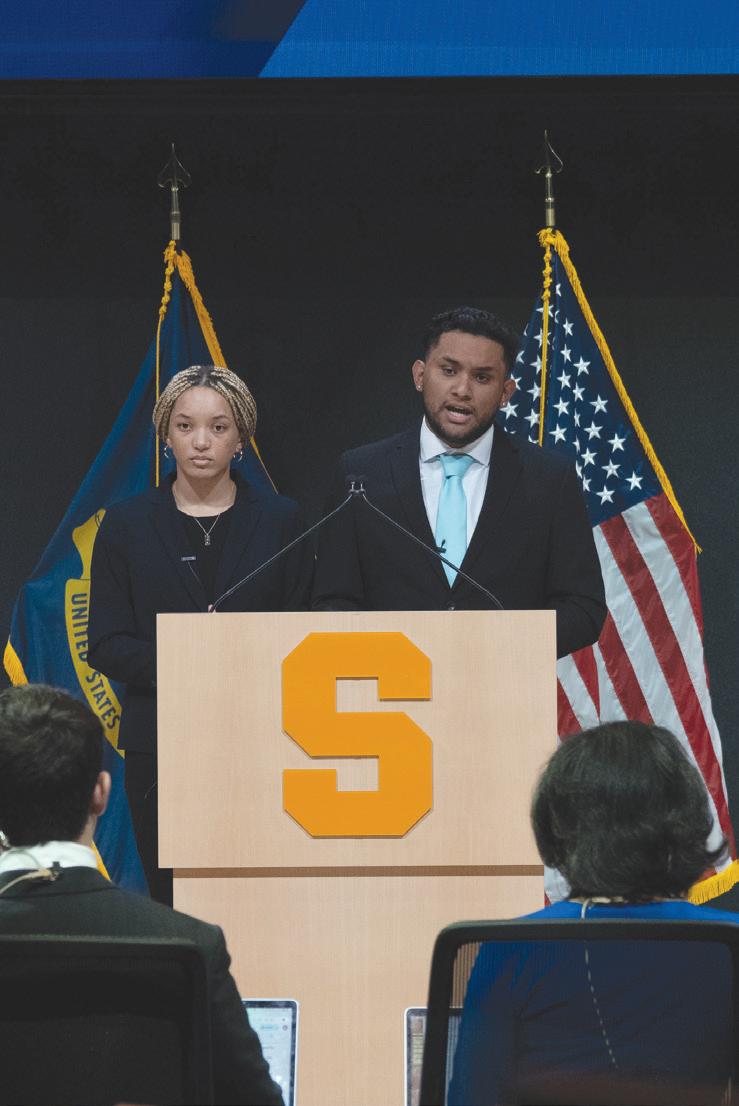
Novilo and Granger spoke briefly about several other issues on campus, voicing their support for student workers’ unionization efforts, increased safety on Marshall Street and improved communication between students and administration.
Novilos and Granger ended their speech by reiterating their commitment to the Syracuse community and their mission statement of listening, learning and leading.
“We are committed to fighting for systemic change and to work with the administration on collaborations to our campus overall,” Granger said. “We are not solely here to ask for your support, but for your partnership.”
bnelson@syr.edu
SU College of Law announces housing clinic for fall of 2024
By Griffin Uribe Brown asst. digital editor
Syracuse University’s College of Law will offer a housing clinic for the fall 2024 semester, according to a Tuesday news release. Clinics provide opportunities for SU law students to represent clients under faculty-mentor supervision, according to the college’s clinics website.
Students in the Housing Clinic will represent low-income tenants in cases involving eviction, housing conditions and other rental
housing-related matters, according to the release. The clinic is the result of a grant from Legal Services of Central New York and the Legal Aid Society, which received additional New York state funding from the Tenant Dignity and Safe Housing Act.
“While providing a stellar educational experience as student attorneys, our clinics also provide much-needed, otherwise unavailable legal resources to the communities and people of Central New York,” according to the College of Law’s website.
Students in the clinic will be supervised by Professor Gary Pieples, the clinic’s director and a teaching professor in the College of Law. However, law students will “handle all aspects of clients’ cases,” including interviews and counsel, investigation and pleading and motion practice, according to the release.
“The Housing Clinic will bring much-needed representation to an underserved population dealing with profound living condition issues,” Dean Craig M. Boise wrote in the release. “At the same time, our students will be gaining practical
legal skills essential to a legal career and a priority in the College of Law curriculum.”
The housing clinic is the College of Law’s seventh in-house clinic, according to the release. The college also offers the Bankruptcy Clinic, the Betty and Michael D. Wohl Veterans Legal Clinic, the Criminal Defense Clinic, the Disability Rights Clinic, the Sherman F. Levey ’57, L’59 Low Income Taxpayer Clinic and the Transactional Law Clinic.
NEWS dailyorange.com news@dailyorange.com march 28, 2024 3
on campus
on campus
gbrown19@syr.edu @GriffinUriBrown on campus
lars jendruschewitz asst. photo editor
After Ruffin served as chair for four years, AAS faculty decided it was time for new leadership, and he stepped down in 2020. Sangmpam said he remembers a meeting in which he asked for applications for chair, but there was no consensus on who should fill the position.
Joan Bryant, associate professor of African American studies, decided to serve as chair for one year. When she completed her tenure, Sangmpam said he expected the department to follow the same procedures but was instead met with “shocking news” — Arts & Sciences decided to look for an outside chair.
“We believe that, regardless of the reason considered for your approval of the external chair search, you have displayed total disregard for matters of governance of the AAS Department,” department members wrote in an April 2021 email.
Lois Agnew, associate provost for academic programs, served as interim chair of the department from 2021 to 2022 and was tasked with looking for an outside chair, Sangmpam said. Sangmpam said that he and Campbell would “not participate in this masquerade,” and, along with several members of faculty, wrote emails protesting the decisions.
Vlad Dima, who holds a doctoral degree in French studies, came to the department as chair and a professor for the spring 2023 semester. He previously served as the chair of the department of African Cultural Studies at the University of Wisconsin-Madison. According to SU’s website, Dima specializes in African and French cinema and teaches a course about soccer in Africa.
The spokesperson wrote in an email to The D.O. that Dima was hired “with the support and endorsement of Syracuse’s AAS faculty.”
Dima spent one semester as the chair of AAS. Campbell said Dima initially indicated that he would like to be “relieved” of the position after the spring 2023 semester. He officially announced his departure on a Sep. 13 Zoom meeting.
“In the discussion about needing a replacement chair, (Dima) stated, ‘it’s the first step of AAS having to rethink its structure and its future,” Bryant wrote in an email to The D.O.
The university spokesperson confirmed that Dima “recently stepped down from the role.” He did not respond to The D.O.’s request for comment.
As Dima departed, he reported to AAS faculty that Behzad Mortazavi, dean of Arts & Sciences, “called for the names of two professors - full or associate - who could step in as chair,” the faculty statement reads.
Campbell said AAS faculty unanimously nominated Ruffin, who has been with the department for 16 years.
Novak said compensation and healthcare were the two “biggest sticking points” within the negotiation process.
SGEU members expressed frustration about the stipend SU proposed at a rally on Jan. 16 — the first day of classes for the spring semester. The union later hosted an “urgent hands-all meeting” on March 4 after SU and SGEU reached a “crossroads” in the negotiation process.
Three days later, over 100 graduate students held a bargaining rally outside SU’s Office of Human Resources prior to a bargaining session scheduled for March 7.
“I think that was really enough to kind of push the administration in order to be like, ‘Oh, this is real, these folks are really going to do a lot in order to get these wins,’” Courtney said. “I think they started making sessions on their side in order to meet us where we’re at.”
At the time of the March 7 rally, SU offered $27,000 for Ph.D. students and $22,720 for master’s students for the 2024-25 academic year with a minimum 2.5% increase for each academic year up until and including 2028-29. SU’s offer of $27,000 for Ph.D. students and $22,720 for master’s students placed below Syracuse’s living wage of $36,865, according to MIT’s living wage calculator.
Under the current agreement, Ph.D. academic graduate assistants and master’s academic graduate assistants will receive a minimum stipend of $28,000 and $24,000, respectively, a slight increase from the March 7 offer.
Novak said SGEU shifted away from focusing on compensation to healthcare and the creation of a “Graduate Assistant Healthcare Support Fund.” Every fiscal year, SU will add $50,000 to the fund to reimburse medical expenses to students who “represent demonstrated financial hardship.”
As part of an election agreement between SU and SGEU, Novak said the union could not go on strike between March 1, 2023, and March 1, 2024. During the negotiation process in February 2024, SU asked SGEU to extend its
“In an attempt to fill the unanticipated gap, we promptly submitted the name of the one faculty member with chair experience who would not have additional administrative responsibilities this semester,” the statement reads.
Arts & Sciences did not accept the faculty’s nomination because Ruffin is not a full professor, according to Greenberg’s email.
Provost Gretchen Ritter has “strongly encouraged” that department chairs selected by all colleges be “currently either 1) full professors; or 2) associate professors who are coming up for promotion to full professor imminently,” the spokesperson wrote.
I see a future in myself in the African American Studies department, and I know some of the other kids do too.
Maria Dut freshman
“This recommendation is so that the responsibilities associated with a department chair role don’t hinder faculty on their path to promotion. The purpose of this recommendation is to empower and support faculty,” the spokesperson wrote.
Because the department has no chair, AAS faculty are currently tasked with additional duties that impede their work, regardless of their professorial position, Sangmpam said.
“All of us, we have become chairs of the department,” he said. “Speaking of killing a department, that is a recipe.”
Mortazavi did not respond to The D.O.’s request for comment.
SU’s political science department recently appointed Seth Jolly, an associate professor, as its new chair.
When asked if Jolly is up for a promotion to full professor “imminently,” SU’s spokesperson wrote that the university does “not discuss the specific details of any professor’s tenure path.”
The dean’s office did not contact the faculty’s candidate for “more than two months,” AAS faculty wrote, and an additional month passed before the office issued its next communication: the Jan. 12 email notifying AAS faculty and staff that the department would have no chair.
“They have made the department — to use their own term — dysfunctional by depriving it of leadership. And they turn around and blame the people in the department who are doing things that they would not do otherwise to keep the place running,” Sangmpam said.
The positions of six faculty — who have either retired or left for other reasons — have not been
replaced since their departures, Campbell said. “Scholarship at any rate is just not their concern,” Sangmpam said.
MLK Library
The MLK Library — which is “the work of African American students, who launched it in 1969 with one shelf of books in the former Black Cultural Center,” according to SU’s website — has not had a full-time librarian since its last librarian retired in spring 2022.
“Since then, Syracuse University’s Libraries have been providing staffing support until a permanent solution can be determined with the AAS faculty,” the spokesperson wrote.
In 1989, the department worked with administration, creating a set of bylaws — called the 13-Point Document — that fostered the growth and institutional status of the department, brought esteemed scholars to SU and created the Pan African studies master’s program, according to SU’s website on the history of the AAS department.
The agreement authorized a full-time librarian for the MLK Library and ordered the “search to begin as soon as possible,” according to the document’s plaque in Sims Hall.
Graduate student workers currently run the front desk of the library under the guidance of Bryant, who multiple students said is working “double” and “triple” time as the librarian of the MLK Library.
Jordan Pierre, a master’s student studying television, radio and film, said students have to be aware of “simple things” — for instance that certain books in the MLK Library can’t be found in Bird — because “if you don’t know, you just remain the victim.”
Funding
Both Campbell and Joy Nyokabi Karinge, who was an AAS teaching assistant for two years before graduating in 2023, believe that the department is not considered viable by the university because it does not bring in much money due to its low enrollment.
There are a total of 34 students in the department — 12 undergraduate AAS majors, 8 undergraduate minors and 14 master’s students in the department’s Pan African studies program — according to the spokesperson.
Karinge and multiple students acknowledged that the department isn’t as profitable as other departments.
Black Student Union President Jordan Beasley emphasized that the department is not being “defunded,” but rather “mismanaged” — citing that he, Dylan France, Aldrick Cade, David Bruen and Adia Santos had “worked on this issue previously” within the Student Association.
“There are very large issues that are going on with the African American Studies department, but I think we need to focus on those issues instead of passing along
the message that the department is being defunded,” Beasley said.
Beasley said the main issue is that the department has not had a “stable” chair for the “past three to four years now.” He added that AAS doesn’t see as much promotion as other departments when recruiting students.
“For us, it’s not purely business. It cannot be purely financial,” Karinge said. “We’re talking about students’ lives … the struggle for Blackness in Syracuse in general. All these Black students coming from all over the U.S. and all over the world, trying to get something from here, are being denied access to that history, to that heritage.”
The future of AAS
The AAS department has “no assurances” that it will “obtain sufficient resources to function as a normal department,” according to the AAS statement.
Multiple students said they feel the university neglects AAS and the Black student population on campus, emphasizing the campus’s need for the department.
“As a master’s student within this department specifically, but also as a Black student within the university space, I feel like the university does not care about us at all,” said Aimée Shukuru, a master’s student in the Pan African studies program.
John Bol Ajak, a current master’s student studying television, radio and film and a former SU men’s basketball player, said a lot of prospective SU students send him messages on social media asking him for advice about the university.
“How can I tell another Black kid to come to this school and they’re not teaching us about our Black history?” he said. “It just is backwards.”
Students emphasized the need for AAS on campus, especially since the university openly highlights that it is “fully committed to fostering a diverse, inclusive and respectful campus community, not only in vision but in practice,” according to SU’s website.
“Syracuse University needs to stop parading diversity, equity and inclusion — needs to stop parading people of color — if they are not going to actually commit to the change that they say they want to see,” Beasley said.
Pierre, who attended the university during #NotAgainSU, said he sees parallels between AAS’s continued issues and the Black student-led movement.
“It don’t feel the same way as it did with #NotAgainSU because #NotAgainSU we had a video — somebody was vandalizing the dorms, putting n*gga on a mirror. Now, it’s morphed. It’s like, ‘I don’t have to blatantly call you a n*gga. I can just remove your books … make y’all feel like there’s no importance to taking those classes,” he said. “It don’t feel the same … But it’s even worse now.”
news@dailyorange.com

no strike agreement until April 1, Novak said. SU and SGEU both agreed to a “no strike – no lockout” provision as part of the new contract.
On Tuesday, Gretchen Ritter — SU’s vice chancellor, provost and chief academic officer — called the negotiation process “thoughtful, constructive and collaborative” in a written statement released after SGEU ratified the new contract. Similar to Novak, Ritter said in the statement both parties worked in “good faith.”
Sobia Paracha, an SGEU member, Ph.D. student in political science and teaching assistant, said the expanded healthcare in the new agreement — which includes dental and eye care — directly helps her and other international students by reducing the financial burden of healthcare costs.
Ashraful Haque, a first-year Ph.D. student in public administration and international affairs and SGEU member, said most graduate students struggle with affording health insurance but that the new agreement would help to mitigate costs.
“Many (graduate students), like me, don’t select good coverage because it’s very expensive, and with our money that we get, we cannot afford it,” Haque said. “So if SU covers 80% of it, then it will be a big support and we’d be more assured of our health if something happens. Many times, we don’t even see a doctor because we are so afraid of the out of pocket cost.”
Paracha said she was happy SGEU worked to secure a better contract but believes more work still needs to be done.
“The university still treats us as students and not as employees in the sense that the money that we make is below the poverty line for Syracuse.
Even with the new agreement, it’s still below that,” Paracha said.
Aysenur Deger, an SGEU member and current Ph.D. student in political science, expressed a similar sentiment and said SU would be more appealing for potential new graduate students if the university offered better pay.
For graduate students who are close to completing their program, it was still important to vote for the agreement for future graduate students, Jooyoung Kim, an economics graduate student and SGEU member, said. For his fellow graduate students, he said voting for the contract guaranteed a minimum living standard.
Courtney said he was “ecstatic and stoked” last spring when the SGEU legitimized itself and became an official union to represent graduate workers. After years of organizing and work, he added it was emotional when both SU and SGEU agreed to the new contract.
“I would never have expected it to go this quickly, to be honest,” Courtney said. “But we were able to think smart, work together and order and mobilize our folks in a meaningful way in order to make this happen in a quick and efficient manner.”
4 march 28, 2024 dailyorange.com news@dailyorange.com
dcchiapp@syr.edu @DominicChiappo2
over two years, Syracuse Graduate Employees United worked to form an official union for Syracuse University graduate student workers in April 2023. On Tuesday, SGEU agreed to an inaugural contract with SU. cassandra
from page 1
For
roshu
photo editor
sgeu
from page 1 aas

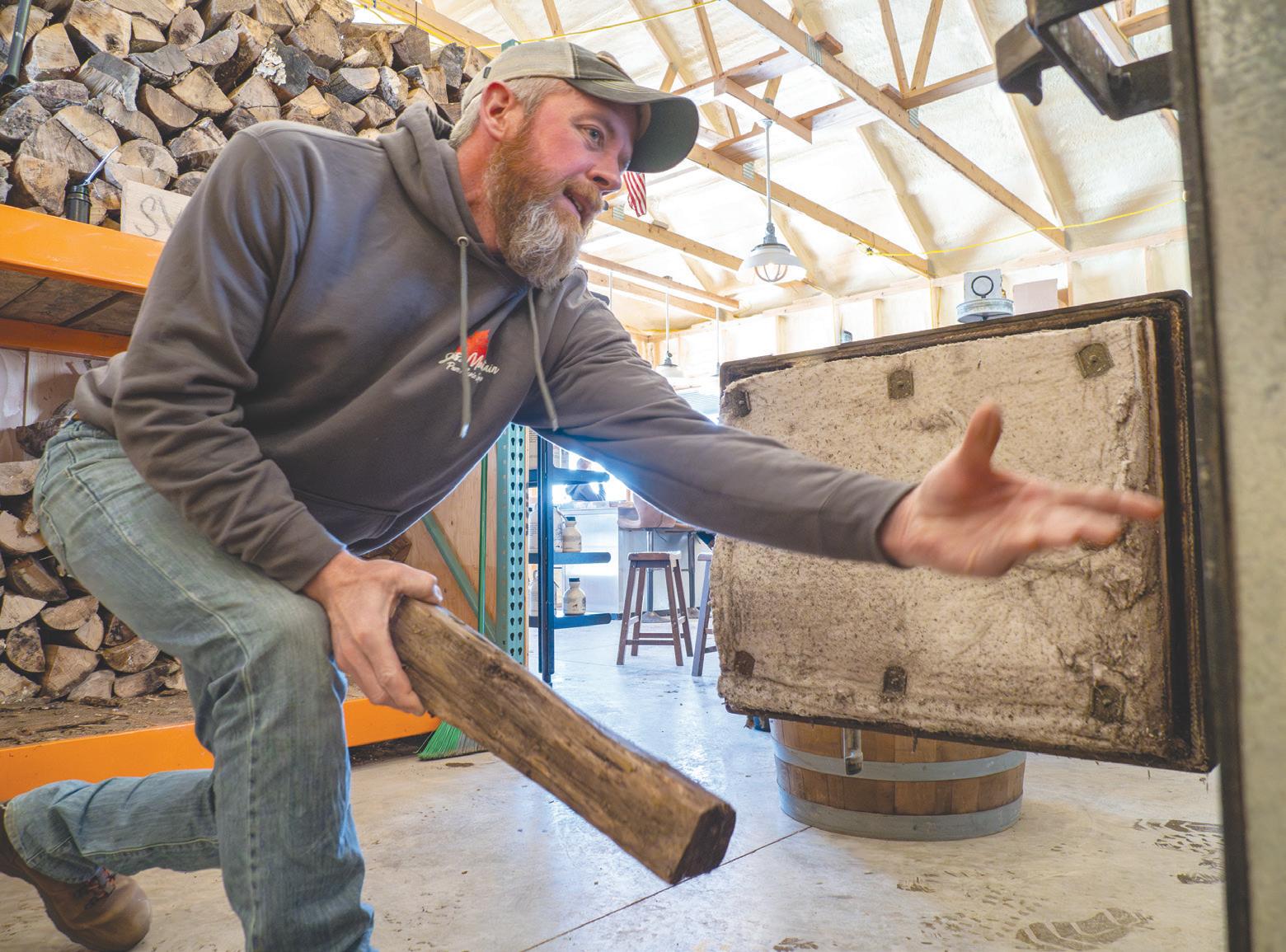
Sticking Together
For many maple syrup farms, the historical and cultural roots are as deep as their maple trees. However, the time frame for making the syrup is shrinking.
By Sophie Szydlik senior staff writer
Even at 94, Clyde Franin still remembers the routine like yesterday –come home from school, hike through the woods to the sugarbush and check the taps. He knew it didn’t matter if it was cold, snowing or if he simply didn’t feel like doing it. When it was maple season, Franin knew it was time to work.
Sophisticated off-road trucks and tapping equipment didn’t exist when he started his routine in the early 1940s. To harvest the sap, he trudged on foot through several feet of snow while carrying a gallon of sap to load on his horse-drawn sleigh.
“It takes about 40 gallons of sap to get one gallon of maple syrup. And we weren’t working with the fancy tech stuff they have now. It was me and those gallon pails praying I didn’t spill climbing over snow banks taller than I was,” Franin said. “I never thought it wasn’t worth it though. Maple season is still my favorite time of year.”
New York State is the second-largest maple syrup producer in the United States, producing roughly 750,000 gallons of syrup per year. Syrup producers, like Franin, tap trees to extract sap that is boiled down into maple syrup through a labor-intensive evaporation process that only occurs in late winter. The sap is highly perishable and only runs under specific weather conditions — freezing nights and milder days.
In 1995, the New York State Maple Producers Association (NYSMPA) introduced Maple Sunday as an opportunity for local syrup producers to engage with their communities. Today, that celebration, Maple Weekend, spans two weekends during March and highlights sugarhouses across the state with cultural roots as deep as their maple trees.
When Matthew Critz purchased what would become Critz Farms in 1985, it was a run-down dairy farm in Cazenovia, New York. Its trees hadn’t been tapped since World War II.
Matthew said that when cane sugar rations were enforced during the war, it led to a rise in alternative sugars, like maple. For struggling wartime dairy farmers, the maple season from February to April offered an avenue for quick cash during their offseason.
“We cut down some old trees a few years ago to make room for new growth and actually saw where taps had gone in years ago during the war,” Matthew said. “Local syrup has always helped people. That’s why we do this.”
Today, Critz Farms averages over 600 gallons of syrup per year. The business has always centered on family, whether that be the tireless work of his wife, “the glue,” Juanita, or his son Patrick, who’s assisted with syrup production since he was a child and continues to today with his own family.
Surrounded by the buttery smell of syrup oozing from the smokestack of the sugarhouse as a child, Patrick can’t remember a time when maple syrup wasn’t a centerpiece in his life. He recalled pleading with his father to be able to lend a hand any chance he had.
Even now, Patrick can’t help but smile when he thinks about his first season in the sugarhouse. The pride he felt serving his community made him fall in love with sugaring. Today, he plans to carry on the family tradition and take over the farm one day.
Noble Cellar owners balance new business with storied history
By Kelly Matlock culture editor
In the 1840s, the church building at 304 E Onondaga Street was a stop on the Underground Railroad. Now, Rob Zaccaria and Sarah Pelligrini, who turned the space into an upscale restaurant, are working with the Onondaga Historical Association to preserve its history.
“A big part of wanting to pursue this space… was to honor it, and let people come into this space and really experience it,” Pelligrini said. “(The building’s history) is a very delicate matter for us … we felt this overwhelming
responsibility bringing awareness to the history.” Pelligrini and Zaccaria graduated from Syracuse University several years apart, opening their restaurant, the Noble Cellar, in February 2023. It is the third restaurant in the space since the church was sold in 2000. The building was erected in 1846 by a group of radical abolitionist Methodists – known as Wesleyan Methodists – who broke away from the church and its pro-slavery beliefs, Zaccaria said. The church was politically active and is the site where Frederick Douglass delivered several important addresses.
The building became part of the Underground Railroad. Fifty escaped enslaved people could take refuge in the building at a time.
Until roughly 25 years ago, the building was the oldest functioning church in Syracuse and continued to hold church services. In 2000, the church was sold and redeveloped into a restaurant –The Mission.
The Mission was an institution in Syracuse, Zaccaria said. The restaurant served Pan-American food and was a popular spot for Syracuse residents and SU students, Pelligrini said. Steve Morrison owned the restaurant
and also spent time working downtown at Pastabilities. After The Mission shut down, the building became Luna Loca, a restaurant that operated for a brief time before closing down after the start of the COVID-19 pandemic. Following its closure, Pelligrini and Zaccaria bought the building, and Noble Cellar was born. With 18-foot ceilings, stained glass windows and original hardwood floors, the space itself is beautiful, Zaccaria said. They aimed to highlight the architecture of the space with renovation. Pelligrini said the Syracuse community has had an “overwhelmingly
wonderful” response to the restaurant’s opening. Patrons have thanked her and Zaccaria for bringing the space back to life.
“I moved back to Syracuse and wanted to be part of its revitalization,” Zaccaria said. “I got talking to people passionate about creating places that elevate what there is to experience in Syracuse, to create and foster community and bring people together.” They decided on the location in Columbus Circle for many reasons –one being its architecture. The circle is home to the courthouse, the cathedral and the library, all with Europe
CULTURE dailyorange.com culture@dailyorange.com march 28, 2024 5
see syrup page 7 see noble
page 7
cellar
beyond the hill
Temperature conditions impact the grade of maple syrup, which is determined by how light or dark it is. lars jendruschewitz asst. photo editor
mark russell at Swiss Mountain Farms stokes the evaporator. It takes over 40 gallons of sap to produce one gallon of maple syrup. lars jendruschewitz asst. photo editor
Metro Boomin, Future prove their mettle with new album
By Savannah Stewart asst. culture editor
In the album trailer of “WE DON’T TRUST YOU,” Metro Boomin and Future drive identical white Rolls-Royces through a desert and step out to pose. Mobb Deep rapper Prodigy, who died in 2017, sets up the album’s stage with a voiceover, speaking of the legitimacy of artists in the rap industry and the luck that follows fame.
“This game is meant for a select few, man. And that’s what it is today, man. I don’t give a f*ck, ain’t nothing changed. Always remember that, ain’t nothing changed. We still here doing it ain’t nothing changed,” Prodigy says.
On “WE DON’T TRUST YOU,” Metro Boomin and Future prove their mettle as icons in the industry. The album was released on March 22 and is Spotify’s most-streamed album in a single day so far this year. The combination of Metro Boomin, an expert hand in quintessential trap beats, with Future, an artist who understands this specialized craft, is the formula for an adventurous, creative dynamic in their first full project as a duo.
This game is meant for a select few, man. And that’s what it is today, man. I don’t give a f*ck, ain’t nothing changed. Always remember that, ain’t nothing changed. We still here doing it ain’t nothing changed.
Prodigy artist
Even beyond its initial visuals, “WE DON’T TRUST YOU” is a complete musical experience, captured in gritty raps centered on shedding dead-weight from relationships and embracing hustle in personal progress.
In the two years before teaming up for “WE DON’T TRUST YOU,” Metro Boomin and Future continued exploring their greatest strengths. Metro Boomin released notable works, including his 2022 album “HEROES & VILLAINS,” and the “SpiderMan: Across the Spider-Verse” soundtrack a year later.
At that same time, Future dropped “I NEVER LIKED YOU.” Marked by low-key flows and eccentric raps, he sprinkled notes showcasing his singing capabilities, like on the heartbreak track “LOVE YOU BETTER.” The project is filled with frank arrogance, a theme common on many of his other tracks,

but highlighted on the album’s eighth song “PUFFIN ON ZOOTIEZ.”
“WE DON’T TRUST YOU” hits a sweet spot for the rapper-producer collaboration. Metro Boomin’s curated rhythms don’t divert far from his typical sounds, while Future’s contributes comfortable, monotone flows. The album is introduced with its title track, where Future articulates the validity of brotherhood.
He begins in repeated, accusatory lines, singing, “Fake written all over you/ Hate written all over you.” A distorted, somber snippet from The Undisputed Truth’s “Smiling Faces Sometimes” (1971) validates Future’s lines and provides a segue to trumpets that bolster a subtle beat drop within the song’s first minute.
Metro Boomin’s reign as a top producer in the rap industry is affirmed as the album continues with features like The Weeknd, Travis Scott, Playboi Carti and Rick Ross. Deep-bass synthesizers and melancholy beats fuse rap and R&B industries’ most loved voices. The series of collaborations makes Metro Boomin’s work even more recognizable. The album continues with “Young Metro.” Co-produced by Houston native Mike Dean, the
second track immediately starts with a booming bass underlying Future’s non-stop, braggadocious bars. Meanwhile, The Weeknd’s melody delicately glides across the song’s break, loosely addressing struggle.
“I been drowning/ I been tryin’/ I been low,” he sings.
Future transitions toward a winding path of redirection in “Runnin Outta Time” as he attempts to overcome turbulent love and the ways others have wronged him. “But I can’t trust nobody, I was down, wasn’t nobody left/ They done turned they back on me, never turned on myself,” Future sings. As the album’s soulful tenth track, detailed with Future’s singing and Metro Boomin’s steady synthesizer overlaid with simple piano notes, the two encapsulate passion and honesty.
“Like That,” however, is quickly becoming the album’s standout, even heading for a position as a top song on the Billboard Hot 100 Chart. The track features Kendrick Lamar, who outshines a so-so melody and Future’s lackluster lines, insulting rappers J. Cole and Drake.
“F*ck sneak dissin’, first person shooter/ I hope they came with three switches…Prince outlived Mike,” Lamar sings.
Lamar’s hard-hitting bars, specifically, take both a stab at J. Cole and Drake’s single “First Person Shooter,” and Drake’s Michael Jackson star status, even referencing the years-long feud between Jackson and Prince. Lamar is known as one to shake up the industry with clever lyricism, a skill reflected in his tough, deliberate bars on “Like That.”
As the album starts to come to a close, Metro Boomin and Future circle back to Mobb Deep inspiration on “Seen It All,” sampling the hip-hop pair’s 1999 hit “Quiet Storm.” The seamless cohesion of Future’s voice and the melody of a classic hip-hop track reminds listeners of Metro Boomin and Future’s combined expertise.
At the end of “Seen it All,” Prodigy’s voice is heard once again. He says, “Who the veterans? Who the seasoned veterans at this sh*t/ That can tell you what’s hot and what’s not?” Throughout the album, Metro Boomin and Future channel Prodigy’s tenacity. This strategic inclusion by Metro Boomin and Future indirectly states that, by hustle and perseverance, they are the current prevailing titans of the rap industry. sfstewar@syr.edu
Our humor columnist’s application to be the next Otto the Orange
By Sarah Wells humor columnist
Dear Otto The Orange Casting Agents (or whomever it may concern),
Upon seeing that you recently had an all-women class of graduating Ottos, I have decided to reach out in the hopes that you are currently recruiting some new, high-energy ladies to play everyone’s favorite orange. I wholeheartedly believe that my experience, along with the fact that I love attention, makes me a great candidate for this position.
In my middle and high school years, I actively participated in theater and drama club, playing many supporting character roles. (To quote my high school theater director, “Leads should have symmetrical faces.”) This experience allowed me to embarrass myself to the point of having absolutely no shame, a skill I think fits the role of Otto perfectly. I’ve also been doing stand-up comedy since November of my freshman year. If you’ve done bad stand-up comedy in a college basement, then I believe you can play Otto with no extra training.
Furthermore, I am very adept at responding to hecklers. Not from my experience with stand-up, to be clear, but from my experience in middle school softball. When I was 14, I had an actual tomato thrown at me once
while I was running from third base to home base. I always thought that throwing tomatoes was a myth, but apparently the woman who lived next to the middle school softball field had a garden.
In addition to all of my extracurricular activities, I also am a stellar student. Well, I’ve gotten a C. And maybe a few Bs. Whatever. I’m stellar. This work ethic would definitely shine through in this position and I also promise to never complain if I have to skip class for away games. That’s just the kind of sacrifice I’m willing to make for this position.
Like many, my favorite Otto memory is them surprising me on a scooter during my freshman orientation. Let’s just say I’m pretty damn smooth on a Razor. I can ride with one hand, two hands, one leg in the air, two legs in the air. (But not for long. Gravity, am I right?) Plus, all of my work in student films has me incredibly prepared to act in any needed SportsCenter commercials or social media content.
Thank you so much for this opportunity. If you need to contact me, I’ve changed my number to 1-800-LUV-OTTO in anticipation. Even though I’m 5 feet 2 inches tall, please hire me. Verizon will not let me change it back.
Sincerely,
Sarah Wells
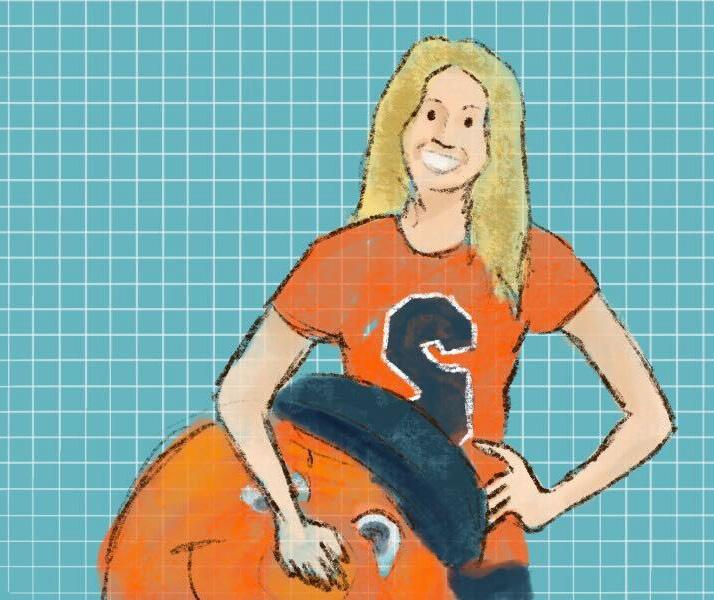
6 march 28, 2024 dailyorange.com news@dailyorange.com
music column
sswells@syr.edu
humor
emma lee contributing illustrator
flynn ledoux contributing illustrator
“I think I was 10 or 11 and I put on a suit to sell syrup to customers in the café. Seriously, I had a tie on and everything,” he said. “I just was so proud to be a part of it.”
But, maple sugaring isn’t the same as it was in 1999 when Critz Farm sold its first boil, Patrick said. The maple syrup season has always been at the mercy of “Mother Nature” and as weather patterns become more unpredictable, he said managing a successful sugarhouse is far more difficult.
When temperatures warm up earlier it makes the sap run earlier, he said. Warm temperatures trigger a response in the tree, signaling it’s time for it to grow buds and leaves. As soon as that signal is sent, the sap changes and no longer has the appropriate sugar composition to be made into maple syrup.
Because of that, sugarhouses are forced to start maple production earlier than normal to ensure they catch sap while it’s usable. If they’re not ready to boil when the sap runs, sugarhouses like Critz Farms run the risk of not harvesting enough and losing an entire season of profits.
“It’s scary. It’s easy for people to ignore this stuff and act like our climate isn’t changing or impacting them but I see (the) impacts every day,” Patrick Critz said.
Critz Farms isn’t a regional anomaly. Jill Rahn, a forest resource analyst in the Department of Forest Properties at SUNY ESF and the leader of maple syrup operations at the Heiberg Memorial Forest campus, has experienced unpredictability with the sap run in the ESF
sugarbush — especially the past two seasons. The first day Rahn boiled in 2024 was on Jan. 27, the second-earliest boil ESF ever recorded, according to data she calculated dating back to 2009.
“Once your sap hits 45 degrees you pretty much need to use it immediately. The yeast in the sap just starts digesting the sugars,” Rahn said. “Even if you get it cold again after that it doesn’t matter. It’s like when you leave milk out. Once it goes bad, it’s bad.”
They really enjoyed (maple sugaring) and like so many people who’ve been doing this for generations, it’s become a family affair for us.
Joanna Baker farm owner
Yet, Rahn said she doesn’t catch herself feeling anxious when looking ahead to the future of maple syrup operations. New York winters aren’t what they were even a few years ago, she said, when she was in the field working on her master’s degree. But, she also knows that through her work during Maple Weekend and the entire season, she raises awareness and protects a tradition embedded in the fabric of New York life for future generations.
“I really like giving the tours to people who have just never experienced this before. They
get the light bulb moment of clicking like, ‘Oh my gosh that’s why maple syrup is $52 a gallon,’” Rahn said. “Having them leave knowing more than they did and having more appreciation … that’s why I love this.”
When she and her husband started sugaring from their garage in 2013, the next generation was at the forefront of Joanna Baker’s mind — specifically, her three children.
“We’ve always tried to get our kids involved in things that help them learn and appreciate what they have,” Baker said. “They really enjoyed (maple sugaring) and like so many people who’ve been doing this for generations, it’s become a family affair for us.”
Baker’s family outgrew their garage evaporation operation and now works out of a brand-new space on their property in Erieville. It’s complete with an evaporator and reverse osmosis machine serving as a home base for their business, Swiss Mountain Farms.
On a windowsill, Baker displays a glass jar filled with antique maple sap taps. Upon first glance, they’re easy to miss altogether, dissipating into the backdrop of the café alongside homemade maple pastries, candies, butter and more.
But, Baker doesn’t mind that. She’s held onto them to serve as a reminder for herself — where she comes from and where she’s going — and to show her children the power of tradition.
“These are the taps my family used to make syrup all the way back to the early 1900s. They lived less than a mile down the road,” Baker said. “Sugaring is hard work and I have a full-time job, but I want to build something to support my kids like my family did for me.”
@sophszyd sophieszyd@dailyorange.com

noble cellar
an-style architecture, but nothing for people to do there, Zaccaria said.
“The building was alive and the building wants to be used and wants to be lived in,” Zaccaria said. “To honor that space is to … create the most beautiful space that we could, while preserving all of the characteristics that we think are integral to that building’s identity.”
Zaccaria put a lot of thought into the restaurant’s name. The word “cellar” is associated with wine, which is what the restaurant focuses on, and a “noble” wine is considered to be a classic, outstanding type of wine. Along with its associations with wine enthusiasts, the name “Noble Cellar” also reflects the history of the building.
“They risked their livelihoods to fight against slavery to be a resource for human beings that were treated like property,” Zaccaria said. “That, as the noble cause that it was, I saw it was very fitting.”
Shortly after Pelligrini and Zaccaria bought the building, they reached out to history curator Bob Searing at the Onondaga Historical Association. They told him they wanted to pay homage to the space and work with him to do so.
Searing said the juxtaposition of the building’s old purpose and current purpose is very interesting. As an educator, he thinks the most important thing is awareness.
“They’ve done a really wonderful job sort of renovating the aesthetic from what it used to be when it was the Mexican restaurant there,” Searing
CONCERTS
Westcott Theater
Couch is performing this weekend at Funk ‘n Waffles. The Bostonbased neo-grunge band combines jazz, a cappella and musical theater into their sound. Couch’s music is best known for its “expressive horns, warm vocals, and bubbling synths,” according to the band’s website. Artist Sophia James is also performing with the neo-grunge band. Tickets to see this seven-piece band and James are available online.
WHEN: March 29 at 8 p.m.
PRICE: $20 - $99
The Song and Dance
Sugar: The Nu-Metal Party is performing on Friday night at The Song & Dance. The concert will play hits from artists Korn, Slipknot, Linkin Park and more. The metal DJ group is on its national tour and encourages attendees to “grab your leash, pack your chainsaw and come and get it,” according to the group’s website. Tickets are available for purchase online.
WHEN: March 29 at 9 p.m
PRICE: $17.20
Funk’n Waffles
The Rollin’ Rust is performing this Friday at Westcott Theater. This folk-rock group hails from central New York and their unique sound combines classic folk with beats from “crazed festivals” and “smoky southern bar rooms,” according to the band’s website. The Rollin’ Rust was also nominated for a SAMMY Award for their 2023 LP “Road Rats.” Tickets for the show are available online.
WHEN: March 29 at 8 p.m.
PRICE: $18.22
The 443 Social Club and Lounge
JW-Jones is set to perform at The 443 this weekend. This Canadian singer-guitarist is known for his highenergy blues sound. Jones is also an acclaimed blues artist, receiving a Billboard Top 10 Blues Artist recognition and a JUNO nomination. Jones has also performed with popular singer-guitarists Buddy Guy and George Thorogood. Tickets for the show are available online..
WHEN: March 30 at 7 p.m .
PRICE: $28.45 - $76.41
Middle Ages Brewing Company
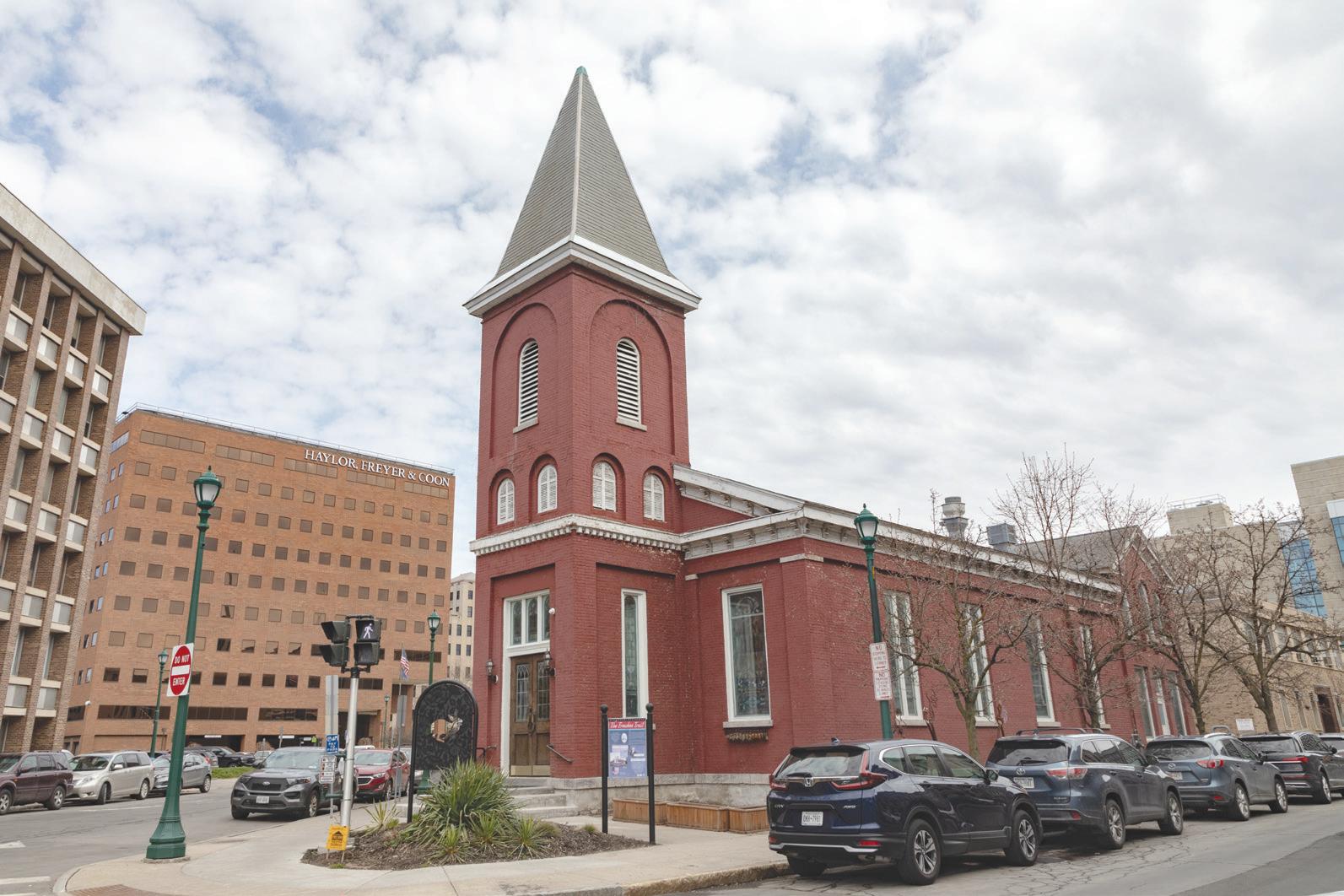
said. “This will be a sort of a long-term partnership, working with them to do programming and other things in the church.”
Pelligrini and Zaccaria are planning a big event in October in collaboration with the Onondaga Historical Society to commemorate the signing of the Emancipation Proclamation. The
weekend will include a reenactment along with other historical events.
“It being a new space where people from not just this community but from all over will come into and sit in the space, that allows for folks to learn a history that they might not have otherwise known,” Searing said. kellyamatlock@icloud.com
Appetite for Voltage is performing Saturday. This Guns N’ Roses and AC/DC tribute band performs authentic “note for note” renditions of some of rock’s rock hits. Founded in 2017, the band features five artists who have toured with The Ramones, ZZ Top and Motley Crue. Tickets for the show are available online.
WHEN: March 30 at 8 p.m.
PRICE: $12.83
Mudpit
moss boy & the critters, XO, Sammy Choz and Troy Conner are performing at house show venue Mudpit on Saturday. Each artist is known for their rock sound. The theme of Saturday’s performances is “moshpit” and attendees are encouraged to “dress to mosh,” according to the venue’s website.
WHEN: March 30 at 9 p.m.
PRICE: $7 presale, $10 at door

march 28, 2024 7 dailyorange.com culture@dailyorange.com
from page 5 syrup
page 5
Maple Weekend allows visitors to learn about the process of local maple syrup production, from tapping the trees to evaporation processes to the bottle you eventually find in the store. lars jendruschewitz asst. photo editor
from
Located in Columbus Circle, Noble Cellar is just one of several historical buildings in the area with European-style architecture. joe zhao asst. photo editor

8 march 28, 2024 dailyorange.com




9 march 28, 2024 dailyorange.com
nick jeppy asst. digial editor
In a post-Roe world, we cannot afford to back down or reverse our activism when it comes to promoting access to birth control and contraceptives

As a California resident, I’m lucky to live in a state that supports the right to an abortion and makes reproductive resources readily available, oftentimes regardless of health insurance. But my heart weighs heavily at the reality that this isn’t the case for millions of others.
Ever since the Supreme Court overturned Roe v. Wade in 2022, reproductive rights have been threatened more in the last two years than in the last few decades of the country’s history. We now live in a country where our mothers, and even grandmothers, had more reproductive rights when they were our age than we do.
With the right to abortions no longer constitutionally protected, it has enabled 24 individual states, overwhelmingly in the South and Midwest, to restrict or ban the procedure at varying times anywhere from the moment of conception to eighteen weeks. Many states, including Idaho, are working to make crossing state lines for abortions illegal as well.
Depending on the state, such as in North Dakota and Indiana, exceptions in cases of rape, incest or threats to the mother’s life may be available, but the laws overall have been heavily restrictive.
It came as no surprise to me, then, that the use of contraceptives has skyrocketed across the country.
In the months after the Supreme Court overturned Roe v. Wade, a TIME magazine survey found that 21% of women had changed their birth control method to include oral pills, condoms or implants. CNN also reported that Nurx, an online mail-order pharmaceutical company, saw a 300% increase in demand for emergency contraceptives.
Now in 2024, the loss of total reproductive rights is a fear – and a fight – that hasn’t gone away. It’s one that’s being addressed by people from all backgrounds and walks of life.
Olivia Rodrigo, for example, is just one of many celebrities who have publicly advocated for reproductive rights, like announcing that a portion of ticket sales from her “GUTS” world tour would be donated to select abortion advocacy organizations.
But this past month, she went one step further by partnering with the Missouri Abortion Fund and Right By You to hand out free emergency contraceptives, including Plan B, condoms, lubrication products and information resources, to fans at her concert in Missouri – one of several states where abortion is now illegal. Her actions felt like a deliberate move to destigmatize and decriminalize reproductive health care.
But, when a fan posted about the freebies online, Rodrigo started to get backlash from pro-life activists and parents of underage fans who argued that some of her concert attendees were children. I found this interesting given

that it’s been a long time since Rodrigo has been the standard teeny-bopper Disney type.
She’s used curse words in her songs from the release of her very first single “drivers license” and regularly explores themes of sex, heartbreak and relationships, notably with older men, in her work. To me, she’s always been upfront with who she is, which is not as kidfriendly as some parents might’ve assumed.
Soon after the backlash, abortion funds stopped passing out emergency contraceptives at her concerts at the request of Rodrigo’s team.
As a 24-year-old adult who is sexually active and three years older than Rodrigo, maybe I’m biased. But this controversy has proven to me that there are just some issues that you don’t back down on. While it’s true that many of her concert attendees are children, it’s also true that she has teenage fans, many of whom may be sexually-active or curious and thus deserve access to contraceptives, information and resources too – notably, for free.
At the average drug store, Julie, one of the emergency contraceptive pills that she distributed at the concert, normally costs $45 per box. This would present a significant financial barrier to anyone but even more so to a teenage audience who can only work limited hours at a job, may be afraid to ask their parents for funds,
may be undocumented and without health insurance or may not have reliable transportation to get to the store in the first place.
By giving it out for free, she not only reduced the stigma of reproductive health care, she also might’ve literally changed someone’s entire life.
Yet, in not standing up to pro-life pearl clutching, she wasted an opportunity to be bolder in her advocacy and address a larger cultural and social taboo that teenagers don’t have sex when they do. Admittedly, the rate of adolescent sexual activity has decreased by 8% since 2019, likely as a result of the COVID-19 pandemic that forced teens to self-isolate and be fearful of one another.
But, if anything, that means comprehensive sex education and open access to resources are that much more crucial to making sex less scary and mysterious. This not only lowers the risk of pregnancy and sexually-transmitted infections but also provides a safe space at school and home to ask questions about their sexual health.
As of this year, only 30 U.S. states require public schools to teach sex education to students. Even more concerning, only 8.2% of LGBTQIA+ teens have access to inclusive, non-heteronormative sex ed at their schools. In a time of so much
uncertainty, everyone, but especially teenagers, deserves full transparency of what reproductive health can look like.
It’s also worth noting, of course, that this controversy stemmed from misinformation and anger in a bigger cultural debate surrounding reproductive rights that are put on the line more and more every day.
As I write this, the U.S. Supreme Court is currently considering a case that may restrict access to the abortion pill, otherwise known as mifepristone. Though safer than Tylenol and Viagra, according to the Center for Reproductive Rights, restricting access to the pill could be yet another move in the pro-life game to prohibit the reproductive freedoms of people all across the country.
At this uncertain time, we simply can’t afford to back down or reverse our activism. As adults — and even more so for adults with social, cultural and political power like Rodrigo — it’s our responsibility to protect the reproductive rights we have left and get back those we’ve lost, not only for ourselves but also for the younger generations whose freedom is invaluable, necessary and sacred.
Sofia Aguilar is a first-year grad student in the Library and Information Science program. Her column appears weekly. She can be reached at saguilar07@syr.edu.
march 28, 2024 10 News Editor Kendall Luther Editorial Editor Olivia Fried Culture Editor Kelly Matlock Sports Editor Cooper Andrews Presentation Director Bridget Overby Digital Design Director Cindy Zhang Photo Editor Cassandra Roshu Photo Editor Maxine Brackbill Illustration Editor Nora Benko Asst. News Editor Julia Boehning Asst. News Editor Ahna Fleming Asst. News Editor Claire Samstag Asst. Editorial Editor Grace “Gray” Reed Asst. Editorial Editor Kaia Wirth Asst. Culture Editor Rosina Boehm Asst. Culture Editor Savannah Stewart Asst. Sports Editor Aiden Stepansky Asst. Sports Editor Justin Girshon Asst. Sports Editor Zak Wolf Asst. Photo Editor Lars Jendruschewitz Asst. Photo Editor Joe Zhao Design Editor Lucía Santoro-Vélez Design Editor Leah Cohn Design Editor Miranda Fournier Design Editor Fernanda Kligerman Digital Design Editor Cole Ross Asst. Digital Edi tor Faith Bolduc Asst. Digital Editor Olivia Boyer Asst. Digital Edi tor Sydney Brockington Asst. Digital Editor Griffin Uribe Brown Asst. Digital Editor Nick Jepson Asst. Digital Editor Timmy Wilcox Asst. Copy Editor Varsha Bhargava Asst. Copy Editor Roxanne Boychuk Asst. Copy Editor Matthew Gray Asst. Copy Editor Ava Lombardi Asst. Copy Edi tor Samantha Olander I.T. Manager Davis Hood Business Manager Kevin Ross Advertising Manager Christopher Ern Business Asst. Tim Bennett Circulation Manager Steve Schultz Student Delivery Agent Hailey Hoang Fundraising Manager Ally Ferretti Anish Vasudevan EDITOR-IN-CHIEF Kyle Chouinard MANAGING EDITOR Stefanie Mitchell DIGITAL MANAGING EDITOR OPINION dailyorange.com opinion@dailyorange.com
madison denis contributing illustrator
SOFIA AGUILAR POP CULTURE PRINCESS

Kholood Eid prioritizes nuance and intentionality when documenting acts of Palestinian resistance
By Kholood Eid palestinian american photojournalist
Editor’s Note: On March 21, the Newhouse School of Public Communications hosted four journalists for a panel discussion titled “Balanced or biased? Assessing US media coverage of the Israel-Gaza war, and why it matters.” One of the panelists was Palestinian American photographer and filmmaker, Kholood Eid. In January, Eid photographed a march in Washington D.C. of protestors calling for a ceasefire in Gaza. She accompanied them with the opinion piece below.
There were multiple themes pulling me through the crowd of 400,000 people in Washington D.C. Saturday, Jan. 13. Clutching my two film cameras on a jarringly bright, unseasonably warm day with a brisk wind that always managed to sneak up on me throughout the afternoon, I immediately found myself drawn towards children spilling out of Freedom Plaza. Children showing up to protest the killing of other
Everything from symbolism to emotion informed my approach to photographing.
Kholood Eid palestinian american photojournalist
children, just as I used to do as a young Palestinian American growing up against the backdrop of a violent occupation and shattered ideals, following generations of others who protested before us.
At least half of the 32,000 Palestinians killed since Oct. 7 have been children, according to the Ministry of Health in Gaza.
Over 10,000 precious young lives lost within four months in a place where the median age is 18. Irish lawyer Blinne Ni Ghralaigh, who is supporting South Africa’s legal team at the International
Court of Justice (and which announced an interim ruling), says the number of orphans caused by ‘Israel’s genocidal assault on the Palestinian population in Gaza has led to the need for a new acronym: WCNSF—wounded child, no surviving family.’ New language was developed in order to describe the unique level of devastation and destruction this population is enduring. It was impossible for me to separate the profound impact this genocide is having on Palestinian children.
I drove down from New York with my friend and colleague, Stephanie Mei-Ling. We discussed giving each other space to create while still making sure to check back in when needed. This was the first protest I attended since they erupted all over the world after Oct.7.
Everything from symbolism to emotion informed my approach to photographing. The outline of the continent of Africa in a woman’s earring stands out in the crowd and in my mind, as I can’t help but think of South Africa accusing Israel of breaching the United
march 28, 2024 11 see kholood eid page 12

Nations Genocide Convention in its response to Hamas’ Oct. 7 attack, which left roughly 1,200 Israelis dead, at the International Court of Justice in The Hague.
I didn’t know what to expect at the march, which has since been reported as the largest crowd of protestors supporting Palestinians in United States history. Generally, I don’t attend or photograph protests because, as I so often describe to friends and colleagues, “Growing up Palestinian left me protested out.” That and photos in some ways felt too easy or too sensational and I craved more nuance and intimacy with my work. This was different. I knew I had to be present and serve as a witness in whatever way that spoke to me on an internal, even spiritual level. That may be why I found inspiration and beauty in quieter moments like prayer or following light when it inevitably cut through darkness, creating a relationship that existed in the contrast, where the duality of pain and perseverance coexists. Even the process around the use of film was a deliberate decision meant to, in some ways, heighten my sensibilities through the understanding that, with only so many rolls of film, I had to be intentional with a finite number of frames to capture what this moment felt like for me — even the physicality of using film was cathartic for me. So too were the sounds of Arabic words floating my way and filling me with a mixture of nostalgia, pride and comfort in being among my own community.

12 march 28, 2024
from page 11 kholood eid

On Jan. 13, over 400,000 people attended a march at Freedom Plaza in Washington D.C. calling for a ceasefire in Gaza and freedom for the people of Palestine. Solidarity efforts brought communities in the African diaspora together alongside youth activists to protest the deaths of Palestinian children. A newborn slept in a stroller with a keffiyeh wrapped around the handlebars.



march 28, 2024 13
That described the 2000 squad. Whatever they were doing, they created their own entertainment. Once the season arrived, the fun was still active, but the internal expectations were remarkably high for a new D-I team.
“There was an inherent pressure to do well, we wanted it to matter and we wanted to win,” Park said.
Syracuse began its first-ever season in Monroe, Louisiana, for the Mardi Gras Classic. In their first game in program history, the
down 203 3-pointers and shot nearly 40% from long range. She earned two All-Atlantic Coast Conference First-Team selections and one AP All-American Third-Team nod. Fair constantly put the Orange on her back this season, highlighted by their first-ever season sweep over Notre Dame, comebacks wins over Florida State and Clemson and a 32-point outburst to lead SU’s NCAA Tournament round of 64 victory over Arizona.
Fair’s career has revealed the blueprint for what players can do in Legette-Jack’s system. The head coach even pointed to Bueckers as an example of what an SU star guard can do with the right pieces around her.
Guards around the country who will be looking for a new home this offseason should be clamoring to come to Syracuse.
“We’re going to show this film to our guards coming in, our guard’s that (are here),” Legette-Jack said of Bueckers’s game versus Syracuse. “This is what excellence looks like. You see Dyaisha’s side of it, now you’re going to see Paige’s side of it.”
“She’s a teaching mechanism. That’s who she is.”
Utilizing the transfer portal has paid dividends for plenty of programs. South Carolina nabbed Te-Hina Paopao from Oregon in 2023 and her steady backcourt presence captained the Gamecocks to an undefeated regular season. LSU brought in Louisville’s Hailey Van Lith to keep it national-title worthy. Even in the ACC, NC State has poached impact players Mimi Collins and Saniya Rivers over the past few years to create consistent success.
Yes, there are current players who will be
turf, Mulé grew his game through backyard battles with his brother. Four years and 183 points later, Mulé transferred from Lehigh to Syracuse as a graduate student where he has seamlessly slotted in, ranking third on the team in scoring. His attacking versatility has helped SU become a top offense in the country.
Each session was different for the Mulé brothers. Sometimes they worked on footwork, other times it was target practice, often misfiring balls into a neighbor’s backyard. Both were lefty attacks and worked on the same drills, but Cameron took his brother’s development personally. As much as they were each other’s “biggest fans,” Cameron made it his mission to make Mulé better than him.
That meant even the sandy beaches of Fair Harbor in Fire Island, Long Island weren’t safe from Mulé and Cameron. The brothers never went anywhere without their sticks, bringing mini-nets on vacation with them.
“We love the game so much that we felt empty whenever it wasn’t around us,” Cameron said.
Lacrosse runs in the Mulé family. His father, Jimmy, was a standout goalie for St. Johns and played two seasons of Major League Lacrosse for the Philadelphia Barrage before joining their coaching staff. In 2005, Jimmy was hired by the Long Island Lizards as their head coach.
Despite the brothers’ youth, the two found comfort on the Lizards’ sideline. When Mulé started playing travel lacrosse, his teammates huddled around the fence at the Mitchel Athletic Complex during Lizards games, clamoring to join him.
Mulé and Cameron frequently embarked on road trips to see the ins and outs of the professional game. They created a bond with players like Nicky Polanco and Brian Spallina — SU attack Joey Spallina’s uncle. Though their lacrosse careers were in their infancy, the two soaked up their surroundings.
Jim didn’t force lacrosse on either of his sons, but it was hard to keep them away from it. The love came naturally as soon as Cameron picked up a stick when he was eight years old and Mulé quickly followed suit. From that point on lacrosse connected the three and became the “center of their lives,” Cameron said.
Playing for Team 91 — Long Island’s premier travel lacrosse program — Mulé continued to develop his skills. Four-hour rides home from
Orange were stomped 8-0 by Wisconsin. Despite a difficult start, Syracuse responded the next day.
In the latter game of a doubleheader, Firnbach’s team defeated Louisiana Tech 6-2, marking the first win in program history.
The Orange had a successful season for a brand-new team, clinching a 24-23-1 record with an 8-2 win over Canisius in their final game of the campaign.
“That was our goal,” Firnbach said of posting a winning record. It was a season of many firsts: the first hit, stolen base and even a perfect game from DiMaggio. On April 25, 2000, she waltzed
back in 2024-25 to collectively help pick up Fair’s mantle. Without hesitation following the loss to UConn, Legette-Jack said Woolley is “ready” to lead the program. Soon-to-be sophomore Sophie Burrows, who drained six 3s to keep SU close with UConn, should also be a key piece. Incoming guards such as Madeline Potts, Olivia Schmitt and four-star recruit Shy Hawkins will be crucial additions, too.
But like Legette-Jack said, Syracuse needs more. That starts in the portal.
SU has a clear need for depth scoring and high-percentage shooters. Only Fair and Woolley averaged double-digit points this past year. And only Fair and Alaina Rice shot more than 30% from 3-point range — both players are set to graduate.
Relying on Woolley to carry the load won’t be enough. Being hopeful for the freshmen won’t suffice, either. The Orange still need an established three-level scorer and a few more efficient 3-point shooters to transition from the Fair era. Snagging transfer portal commits is the safest option for Syracuse to fill its backcourt needs.
The same goes for the frontcourt. Alyssa Latham, Kyra Wood, Saniaa Wilson and Izabel Varejão all seem to be coming back in 2024-25. But while that group helped Syracuse become one of the better rebounding teams in the nation, it was inconsistent. Starting frontcourt lineups varied throughout the campaign and nobody stood out as a scorer.
SU needs to find its next great big — one who can provide it with consistent post scoring. The options for next season start and end with Pittsburgh’s Liatu King.
Pitt’s All-ACC First-Team forward dropped 18.7 points and 10.3 boards per game on 52.3% shooting. She dominated
through Buffalo’s batting order for all five innings, striking out 10 in the first of just two perfect games in Syracuse history.
In the six seasons that followed with Firnbach at the helm, the Orange put together three winning seasons. Leigh Ross took over in 2007, and led Syracuse to three straight NCAA Tournament appearances from 2010-12, as well as two Big East Championships in 2010 and 2011.
SU has boasted three all-American players, including pitcher Jenna Caira, who was a member of the Canadian National Team and has her No. 29 retired by Syracuse.
Now, the Orange are a member of the Atlantic Coast Conference — one of the most competitive conferences in the country — with the likes of Clemson, Florida State and Duke annually penciled on their schedule. But Syracuse wouldn’t be where it is today without the first batch of women who established the program.
“To think that Syracuse (softball) has only been around for 25 years and they’re doing the things they’re doing now, it’s just phenomenal,” Cookson said.
nsjepson@syr.edu
@nicholassjepson
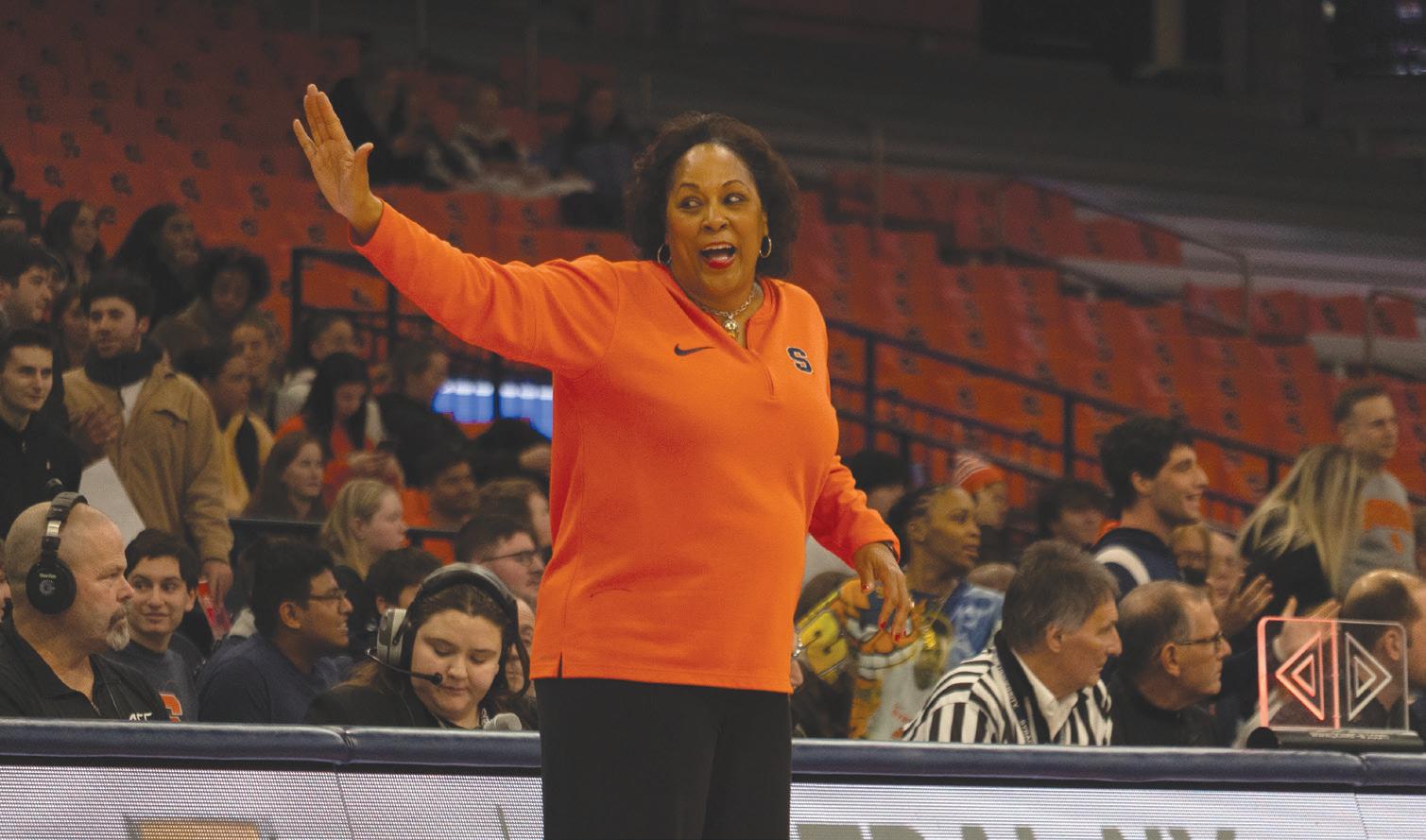
Syracuse in two matchups across 2023-24, posting double-doubles in each with 27 and 29 points, respectively.
King just finished up her fourth season for the Panthers, who are a bottom feeder in the ACC. She’s eligible for a graduate year. Why can’t Syracuse get her? Legette-Jack, who normally doesn’t laud opposing players, would clearly be open to the idea. “She’s a monster, she is so good,” Legette-Jack said of King on Feb. 25. “She’s an undersized post player that can score buckets … But somebody’s gotta have a good vision (for her).”
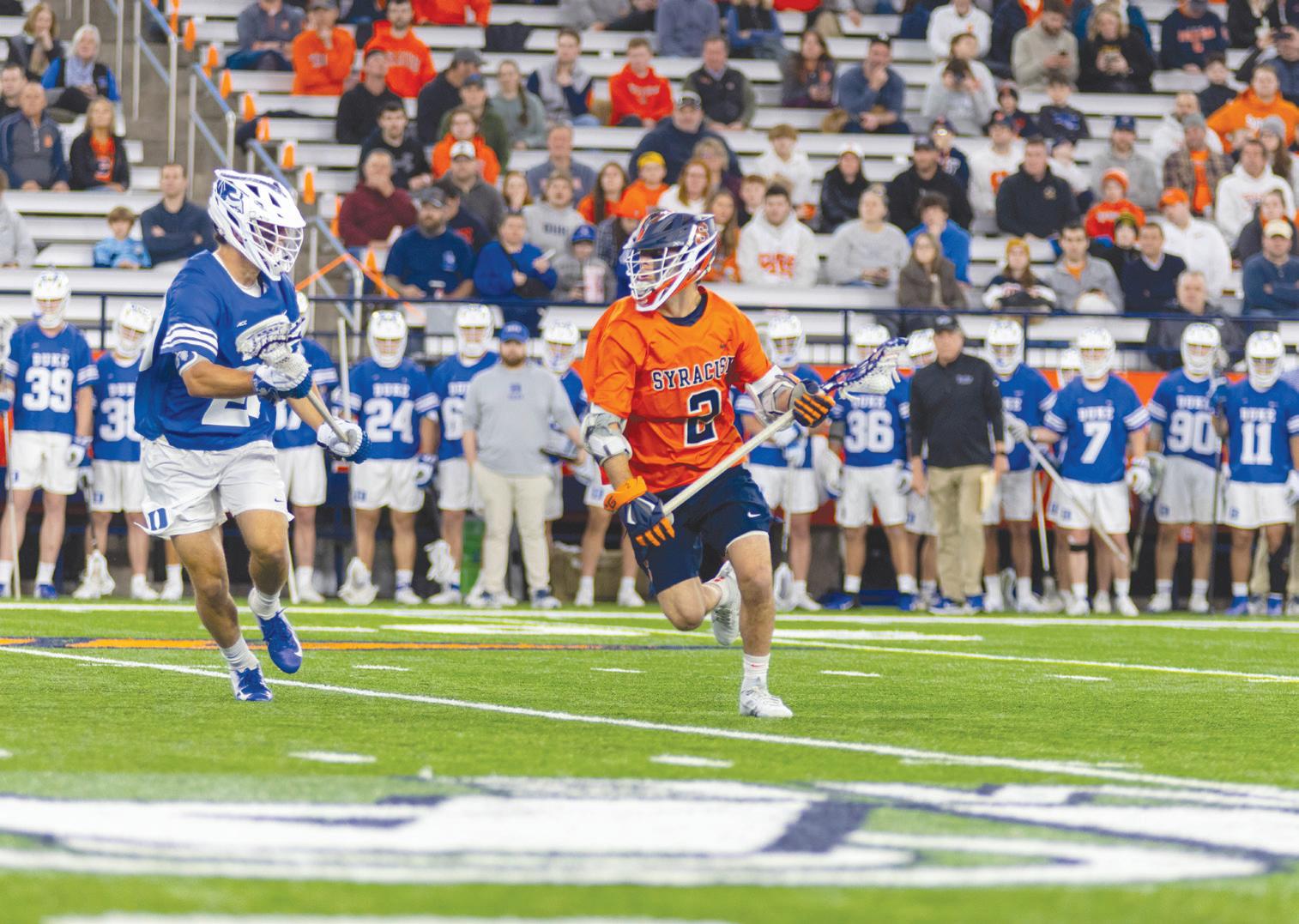
tournaments led to more backyard work rather than naps on the couch.
“We would always try to find a way to make it work,” Mulé said. “It didn’t matter how cold it was or what the time was, we were always trying to work on our craft together.”
In eighth grade, Cameron played for Half Hollows West High School and Mulé joined two years later. By then, Cameron developed into an elite attack while Mulé was more of a man-up specialist.
Mulé called it the “best years playing lacrosse together.” But in 2018, Cameron headed south to play at Duke, leaving Mulé with a void.
“It was definitely like I was missing a part of me when he was gone,” Mulé said. “I had to try to find a way without him.”
He no longer returned home and immediately raced to the backyard. Mulé said friends came over to practice, yet nothing excited Mulé more than when his brother came home.
Cameron passed down the knowledge he learned at Duke to Mulé. He emphasized focusing on smaller details. Cameron also implored Mulé to not be one-dimensional.
Mulé took the advice to heart and made an instant impact at Lehigh with his finishing
ability, catching the eye of former Lehigh and Syracuse midfielder Cole Kirst during fall ball in 2020. Labeled as a “scrapper” by Kirst, Mulé did the dirty work. His work came to a head in his first college scrimmage as Lehigh played Syracuse at Onondaga Community College.
Facing one of the top teams in the country at the time, Mulé wasn’t fazed. He grew up watching Syracuse, so he made the most of his opportunity.
Mulé scored the first four goals of the game, including a behind-the-back finish which Kirst labeled as “one of the best goals he’s ever seen.”
Jimmy wasn’t present for the scrimmage as he was with Cameron in Durham. He kept up with the scrimmage through a parent group chat. Each time someone scored, a parent provided an update. Jimmy kept peering at his phone. It kept reading “goal Mulé.”
“I thought the parents were fooling around with me,” Jimmy said.
As Mulé gained experience, his game evolved. Known as a finisher his first three seasons, he was trusted with being a primary offensive initiator as a senior. More slides came Mulé’s way. He adjusted by dishing out a career-high 44 assists — ranking third in the country — after registering just 30 in his first 32 games at Lehigh.
To complete Legette-Jack’s master plan, being aggressive in the transfer portal is a must. It’s the only way for them to win now. It’s the only way for them to pave their recruits an easier path into their collegiate careers. And it’s the only way to complement their current group with established stars who can propel them into bonafide national contenders.
A riveting 2023-24 was merely the rough draft. Syracuse now has to make the proper revisions to create a doctrine of sustained success.
Cooper Andrews is the Sports Editor at The Daily Orange, where his column appears occasionally. He can be reached at ccandrew@ syr.edu or on X @cooper_andrews.
Syracuse has the potential to be a team to be reckoned with. Fair’s historic career has shown prospects how Legette-Jack’s system can do wonders for sharpshooting guards. Woolley, Burrows and Latham lead a promising group of returnees. And Hawkins spearheads a dangerous 2024 recruiting class.
“He’s a sponge and that’s what makes him such a great player because he’s able to alter his game based on the strengths of others,” Kirst said.
The ability to blend in wherever needed led to a perfect transition at Syracuse. The free-flowing offensive style implemented by associate head coach Pat March made Mulé’s choice simple.
In 11 games with Syracuse, Mulé has scored 21 goals and dished out 11 assists. But his biggest moment with the Orange is one he’d like to forget.
There was one game Mulé circled on his calendar: Army at home on Feb. 28. The Black Knights were one of Lehigh’s rivals in the Patriot League and sent the Mountain Hawks home in the semifinals of the conference tournament in 2023. The game was personal for Mulé. And in overtime, Mulé had the chance to be the hero.
After an empty Syracuse possession to start overtime, Army attempted a clear. Mulé poked the ball loose around 30 yards out, took one look and lofted it toward the open net. But it went wide. Army came down the field and Jackson Eicher scored the winner.
Mulé was crushed. The play repeated in his mind for days. Mulé spoke with defensive coordinator John Odierna, who told him he was allowed to be upset but to wash it out.
“You can’t beat the army anymore” Odierna told him.
The same sentiment echoed from friends and family.
While the miss still lives in his head, Mulé has moved on. On March 9, Syracuse led 14-13 against then-No. 2 Johns Hopkins with 10 seconds left. Brett Martin controlled the ball, but Mulé closed him down and forced the ball loose. Martin regained it yet threw the ball out of bounds as Syracuse sealed its first-ever win against a top-five opponent under Gary Gait.
Redemption. This time, the ride worked out in his favor.
Just like in the backyard, nothing came easy for Mulé. Guided by Cameron, lacrosse became an unavoidable lifestyle for him. The two bonded over their goal of winning a national championship one day and while Cameron came up short with the Blue Devils, the responsibility now lies with Mulé.
“We loved watching college lacrosse and watching teams compete for a championship so that was always in our heads when we were playing,” Cameron said.
dailyorange.com sports@dailyorange.com 14 march 28, 2024
from page 16 anniversary
from page 16 portal
Felisha Legette-Jack helmed the Orange to a resurgent 2023-24 season, which culminated in the program’s first NCAA Tournament win since 2021. sadie jones contributing photographer
zakwolf784254@gmail.com @ZakWolf22
from page 16 mulé
Christian Mulé’s passion for lacrosse was spurred through backyard training sessions with his older brother Cameron. arnav pokhrel staff photographer
Emma Ward, Tyrrell score 10 goals in SU’s win over Loyola
By Justin Girshon asst. sports editor
After Emma Tyrrell netted Syracuse’s first goal of the second half for a 9-8 lead, Emma Muchnick won the ensuing draw — SU’s second win in a row after losing 9-of-12 beforehand. Possession quickly changed hands twice, but once the Orange regained the ball, they fed Emma Ward at X — something they lacked throughout a sluggish first half.
Naturally, Ward capitalized on the opportunity, bulldozing her way by Logan Olmstead toward the left side of the eight-meter. Because of Ward’s domination as a one-on-one player, Loyola defender Lily Osborne moved off of Tyrrell and toward Ward. Ward — SU’s leading assister — looked toward the middle of the crease and hit Tyrrell in stride on a backdoor cut. Goalie Lauren Spence was left helpless, jumpstarting the Orange for a 6-0 second-half run where the Emmas dominated.
The Orange’s offense has been a well-oiled machine this season on the back of their depth, but facing Loyola, Ward and Tyrrell took over. In No. 5 Syracuse’s (8-3, 5-0 Atlantic Coast) 16-13 win over No. 7 Loyola Maryland (9-1, 4-0 Patriot League), Ward (4) and Tyrrell (6) combined for 10 goals, handing the Greyhounds their first loss of the season. Despite a backand-forth first half, poor draw control play (12-for-31) and Delaney Sweitzer struggling in the cage (23.5% save percentage), the Emmas propelled SU to its fifth consecutive win after starting the season 3-3.
“I thought we had some big performances, especially on the offensive end (from) Emma Ward and Emma Tyrell,” SU head coach Kayla Treanor said.
After Tyrrell and Ward connected to put the Orange up 10-8, they got the ball back to Ward at X with the same matchup versus Olmstead. This time, SU cleared out, letting its star go to work. Ward bulldozed her way toward the middle of the eight-meter, and instead of dishing, nailed a behind-the-back snipe extending the Orange’s lead to 11-8 at the 7:09 mark of the third.
“It’s just playing within the system and just knowing when the right time to do things is,” Ward said “The first time they kind of hedged and Emma made a great backdoor play … The next time is just understanding the situation, they weren’t hedging and sliding and she was playing me heavily topside.”
Ward’s goal led Syracuse to its second 3-0 run of the game, but unlike it did in the first
half, SU kept its foot on the gas pedal. After a two-goal first quarter where the Orange didn’t feed Ward at X and Tyrrell squandered her best scoring opportunity, they broke out in the second quarter.
Even though it was a period where SU lost nine straight draws, Ward scored two quick goals, with her second starting a 3-0 run where Natalie Smith and Tyrrell gave Syracuse a 7-4 lead 6:49 until halftime.
But as it did in its loss to Stony Brook, SU let Loyola embark on a 3-0 run, tying the game back up. The Orange’s defense did a great job containing the Greyhounds for most of the first half, but when the draw control unit struggles, SU allows scoring runs.
Payton Rowley gave Syracuse much-needed momentum going into the break, scoring a last-minute first-half goal. Yet, as Loyola did throughout the first half, it fought back, tying the score 8-8 three minutes into the second half with a goal from Regan Kielmeyer. Though that was the last time the Greyhounds scored for nearly an entire quarter as Ward and Tyrrell took over the third quarter.
Following back-to-back goals from Tyrrell and Ward after Kielmeyer beat Sweitzer — who only saved 4-of-17 shots on goal — the Orange’s gameplan was clear: feed the Emmas.
“We saw they were being really aggressive (early) and they were doing certain slides to certain people, so being able to adjust midgame was something really big, big for us,” Tyrrell said.
As SU’s draw control heated up — winning 5-of-6 third-quarter draws — Muchnick controlled her second in a row, leading the Orange to put the ball in Tyrrell’s stick. And, just as she’d done throughout the game, Tyrrell maneuvered her way through the Greyhounds’ defense, scoring less than a minute after Ward’s behind-the-back shot.
Savannah Sweitzer then poured in her second of three goals, giving Syracuse a 13-8 lead heading into the fourth quarter, but Tyrrell continued her hot streak to start the fourth.
After Olivia Adamson — SU’s leading point scorer entering the game who was held to just one assist — missed a free position shot off the pipe, she scooped the ground ball and scored her sixth goal, a new season high.
Loyola finally ended SU’s scoring run at the 11:18 mark of the fourth quarter and then cut its deficit down to 14-10 after Chase Boyle scored. But Ward ended the Greyhounds’ mini run.
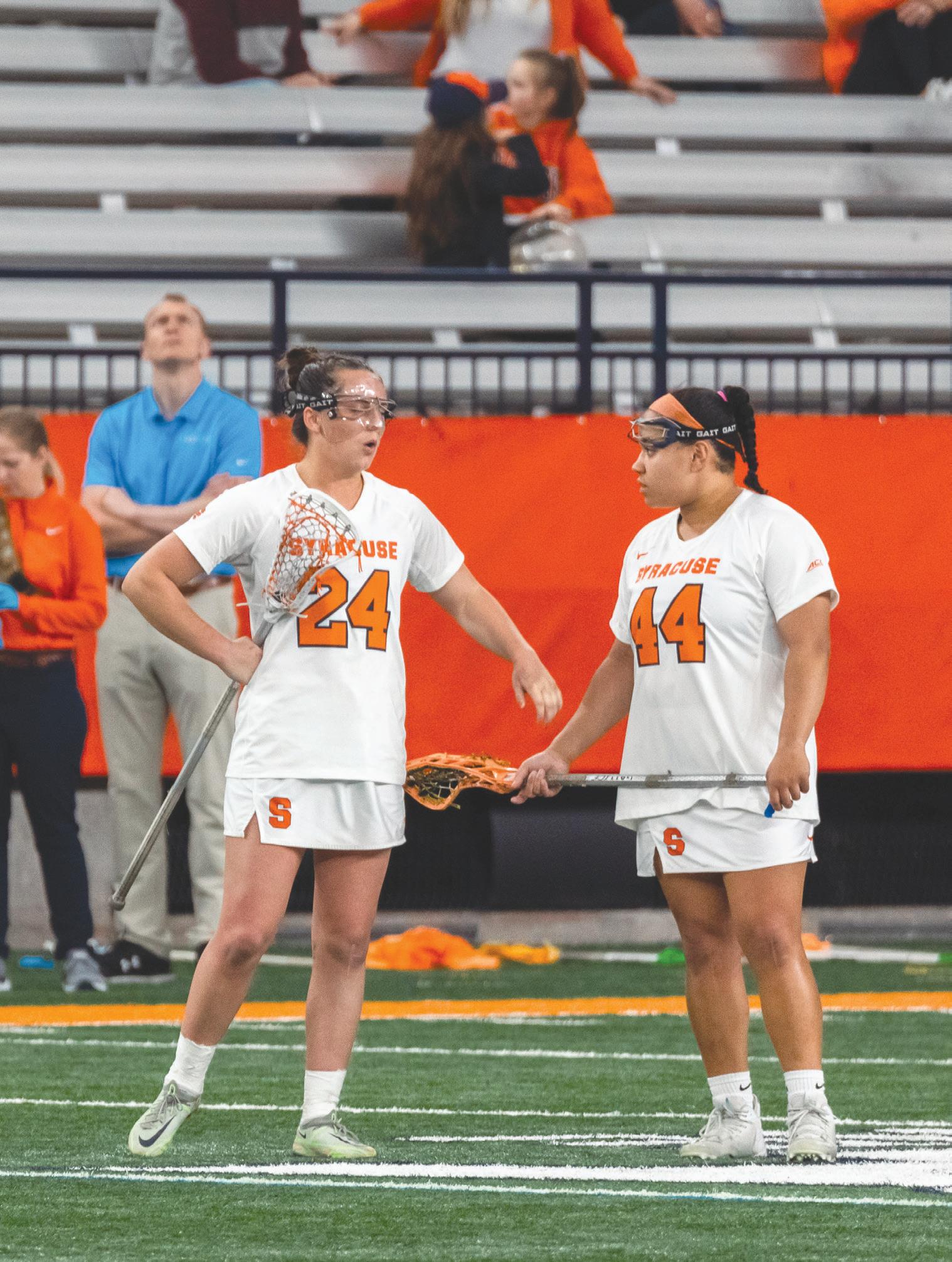
Emma Ward and Emma Tyrrell racked up 10 goals to lead No. 5 Syracuse to a 16-13 win over No. 7 Loyola in SU’s fifth straight victory. joe zhao asst. photo editor
Isolated with Olmstead yet again from X, Ward maneuvered her way right in front of the crease. Though Olmstead stayed in front of her, Ward attempted a side-armed shot around the defender and scored her fourth goal of the game — tying her season-high — with 8:30
remaining. From there, Syracuse’s defense closed the game out, securing a 16-13 win.
“We needed an out of conference big win and we got one tonight,” Treanor said.
justingirshon@gmail.com
@JustinGirshon
Beat writers split on No. 3 Syracuse’s chances vs. No. 1 ND
By Daily Orange Sports Staff
No. 3 Syracuse has reached its highest ranking under head coach Gary Gait following wins over then-No. 4 Duke and Hobart. Still undefeated in March, the Orange are firing on all cylinders with four games left in the season.
Now SU has its toughest test of the year, facing No. 1 Notre Dame in South Bend, Indiana. The Orange haven’t beaten the Fighting Irish since 2018, losing by an average of just over 10 goals in their last five matchups.
Here’s what our beat writers think will happen when No. 3 Syracuse (9-2, 1-0 Atlantic Coast Conference) takes on No. 1 Notre Dame (5-1, 0-0 ACC):
Zak Wolf (7-4)
Close but no cigar
Syracuse 9, Notre Dame 11
Notre Dame is by far the best team in the country at this point in the season. It has the top-ranked offense and defense in the country on top of having a complete roster. Although SU has faced stiff competition in 2024, the Fighting Irish are its greatest test.
With two potent attacks, this game will come down to the goalies. Will Mark and Liam Entenmann are two of the best goalies in college lacrosse. Entenmann is the reigning 2023 NCAA Tournament Most Outstanding Player while Mark is one of the hottest players in the country. As good as Mark has been the past three games — 17 goals allowed and a 71% save rate — Entenmann is better. Entenmann dominated the championship game last season, recording 18 saves against Duke.
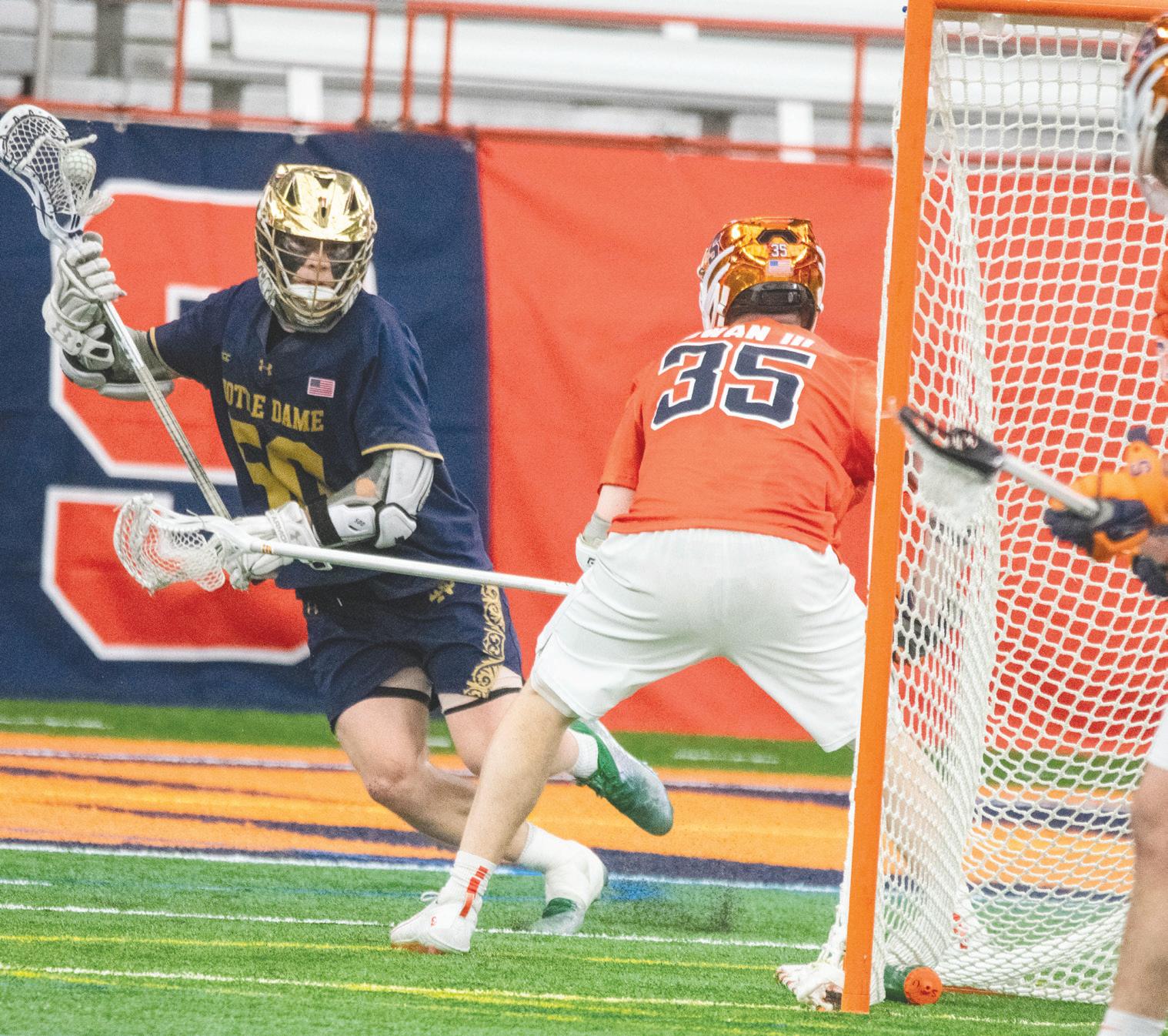
Beating Notre Dame’s stingy defenders will be tough, but getting past Entenmann is even tougher. Joey Spallina and the rest of the attack can’t afford to have an off day. The Orange have the benefit of not relying on a single player to produce the majority of their offense with nine players scoring at least nine goals this season. But as many weapons as SU has, Notre Dame has experience on their side, helping it eke out a win.
Cooper Andrews (8-3)
Running out of luck
Syracuse 12, Notre Dame 14
The Orange are on a tear. A five-game winning streak. A top five team faceoff winning rate in the nation (61.6%). Major wins over then-No. 2 Johns Hopkins and then-No. 4 Duke. The best national ranking (No. 3) in Gait’s three-year tenure. But at some point, your luck turns against you. And Syracuse’s recent good fortune will end versus the Fighting Irish. The good fortune I speak of resides in SU’s defense. It’s been nothing short of incredible over the last few games, particularly against the Blue Devils. Led by Mark and long pole Billy Dwan — who just won National and ACC Player of the Week,
respectively — the Orange quelled Duke’s then-No. 1 scoring offense in the country to just four goals. Star attack Brennan O’Neill only mustered one.
I don’t see a similar performance playing out Saturday. Notre Dame’s offense is electric. It’s No. 1 in the nation in shot percentage, shot-on-goal percentage and efficiency while it’s also second in Division I in turnover percentage. The Fighting Irish also have Jake Taylor, who’s tied for the third-most goals per game in the country with 3.67. SU’s defense isn’t experienced enough to remain consistent against a juggernaut like ND, and I think John Odierna’s group will suffer a brief setback.
Anish Vasudevan (10-1)
Luck of the Orange Syracuse 12, Notre Dame 10
This is where being atop the beat writers’ predictions plays into my favor. I can take a big swing if I want to with no actual repercussions to my place in the standings. So this week I’m turning into Pablo Sandoval.
A few weeks ago, I wrote that the Orange could very well win the ACC. The reason I said that is because the giants of the conference have strayed away from their usual dominance. Every team lost in the span of six days earlier in the season, including Notre Dame losing to Georgetown. The Hoyas silenced the Kavanagh brothers, allowing them to score just two goals. With Odierna’s defense coming off a monster performance against the Blue Devils, I think they could do something similar.
Syracuse is completely different from the team that lost by eight goals to Notre Dame last season. In that game, SU gave up a one-goal advantage by losing six straight faceoffs. With Mason Kohn and John Mullen this year, that won’t happen. Kohn and Mullen are the ones who will finally close the talent gap between both programs, ushering the Orange as they break their curse against the Fighting Irish. Time to play “Passionfruit” and party like it’s 2017.
dailyorange.com sports@dailyorange.com march 28, 2024 15
lacrosse
women’s
sports@dailyorange.com
men’s lacrosse
Syracuse hasn’t defeated a No. 1 team in the nation since 2017, and has another shot against No. 1
Notre Dame Saturday in South Bend, Indiana. jacob halsema staff photographer
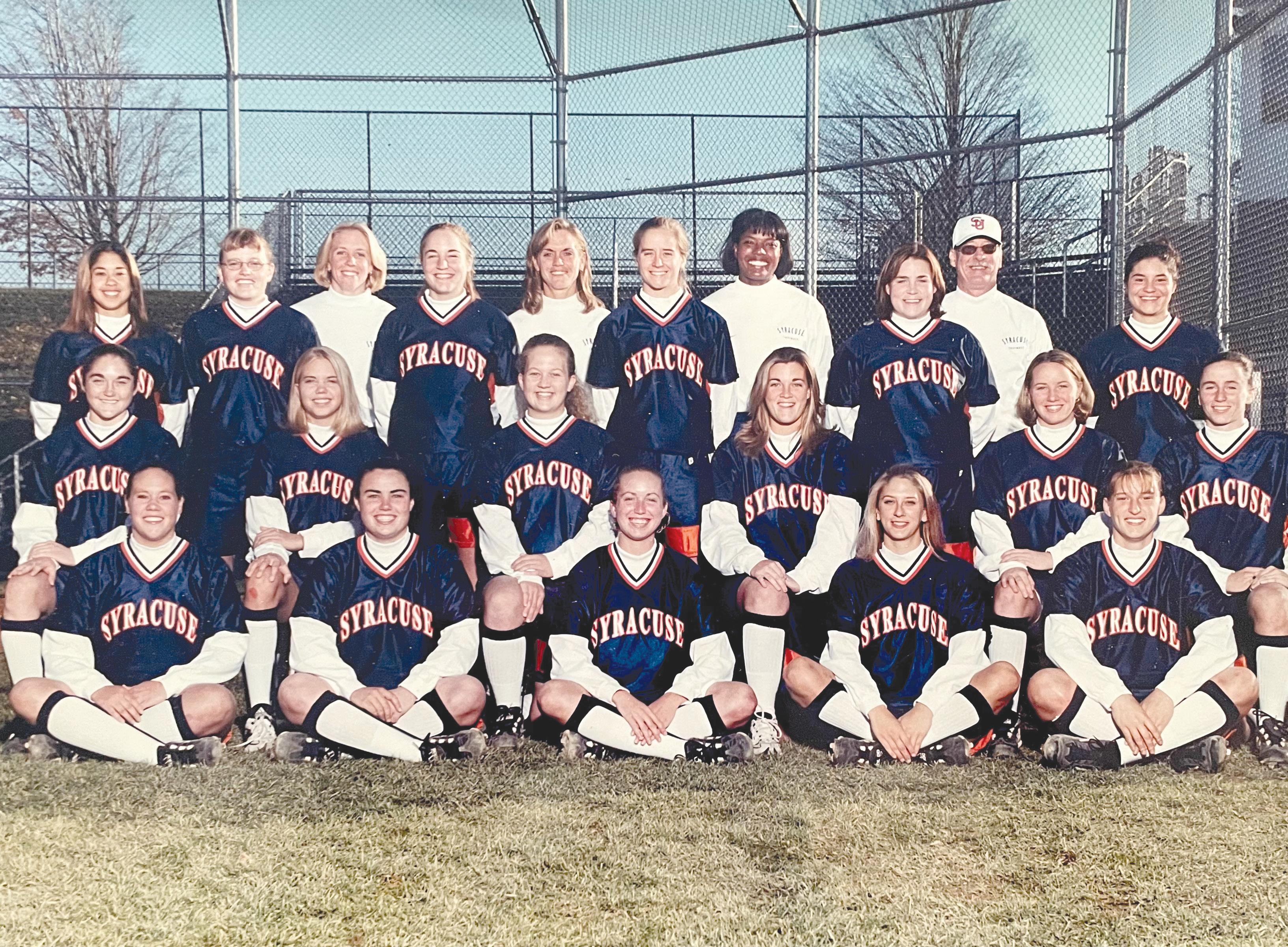
to a winning
Syracuse softball began with scarce resources and a team mostly formed through an open tryout. The program’s debut campaign set the stage for SU’s modern era.
By Nick Jepson asst. digital editor
Becky Cookson arrived at her first Division I softball practice as one of five walk-ons on Syracuse’s inaugural softball roster. She made the team through a series of tryouts, conducted to fill the last spots of the squad.
Yet, the excitement that could, and perhaps should, have overwhelmed her in the moment was absent. Something was off. She and the four other walk-ons didn’t quite fit in.
They stared at 11 new teammates, all of whom were recruited to the team by head coach Mary Jo Firnbach. The recruits sported matching practice uniforms and stood in one cohesive unit. Meanwhile, Cookson and the other walkons donned street clothes. It didn’t seem like they were equal at all.
Despite differing statuses, everyone had one monumental thing in common: they were the first group to play D-I softball for Syracuse University.
In the late 1990s, SU added three new women’s sports — soccer, lacrosse and softball as a result of Title IX. Though, softball was the most behind because there was no men’s equivalent in place
men’s lacrosse
Division I
to provide them with basic necessities like a field or equipment. The program had little to work with and needed to build from the ground up, celebrating its 25th anniversary as a D-I program this year.
Firnbach helmed SU’s first season and six afterward. She was only 29 when she decided to throw her hat in the ring for the head coaching job after being an assistant at Southern Illinois, Michigan, and Illinois State.
“I’m like, oh I probably won’t get it,” Firnbach said, “I don’t have any head coaching experience.”
But her connections with Jake Crouthamel, Syracuse’s then-Athletic Director, and Janet Kittell, the former Associate Director of Athletics for Operations, helped her get an interview. To her surprise, she got the job. Yet, she faced a steep mountain to climb.
“When I was hired, there was no field,” Firnbach said, “there was no equipment, there were no players. There was nothing there.”
24
Firnbach was hired in 1998 and from there, she worked to acquire the necessary tools to create a D-I program.
Once pitcher Tara DiMaggio, a New York native, signed with the Orange, Firnbach got the ball rolling. But the recruiting process was unorthodox due to the limited resources. DiMaggio stayed with a player on the women’s lacrosse team and Rachel Park, another recruit, stayed with a volleyball player.
Still, DiMaggio and Park were sold on Syracuse. Firnbach brought in nine other players to complete SU’s first recruiting class. The 11-player group was mostly made of freshmen along with some JUCO transfers.
To deepen her roster, Firnbach turned to open tryouts. These players weren’t novices
to the game, as SU already housed a co-ed club softball team. Firnbach drilled the 30-plus women trying out for hours, searching for hidden gems to add to the club.
“I was definitely nervous,” Cookson said. “Because I knew I wanted to be (on the team).”
Following the tryouts, Cookson and four other walk-ons’ had been selected for the team. Firnbach knew they belonged, even if they weren’t the most talented.
“The people that we brought in were phenomenal,” Firnbach said. “(They were) people passionate about the university and excited to be there.”
It wasn’t just Firnbach who saw the recruiting class’s potential.
“They just did it because of the love of the game and the sport and just wanting to be a part of the team, so that was a really special group,” DiMaggio said.
With a full roster, some equipment and a field, the plan was in motion. The only thing missing was a stable foundation. But Firnbach knew the right way to familiarize the group with one another. The girls, from all different regions of the country and Canada, came together at Firnbach’s house to bond.
It became a tradition to head over to the house on Cumberland Avenue for dinners and holiday parties. Despite the discrepancies between the recruits and walk-ons in the beginning, status didn’t matter anymore. They became a team.
“We spent a ton, probably an unhealthy amount of time together,” DiMaggio said. “We liked spending time with each other just as much off the field as we did on.”
Practicing for the season wasn’t easy without many of the necessary resources at their disposal. Harsh Syracuse winters forced them to practice in the then-Carrier Dome on the half not being used by SU’s basketball team. But the team grew resourceful, setting up batting cages in the Dome’s top-level concourse.
They also found ways to make cleaning the field enjoyable when they moved outside in the spring. Each player constructed a snowman in the outfield, and when they were finished with their masterpieces, threw it over the fence to get rid of the snow.

No accomplishment in 2023-24 for Syracuse women’s basketball could rival the praise UConn head coach Geno Auriemma lavished upon the program. The 11-time national champion was uneasy before facing SU in the NCAA Tournament round of 32. He had to catch his breath after the Orange nearly slayed his mighty Huskies on their home floor.
“Well, I told you yesterday I wasn’t crazy about our bracket because I knew what we were up against,” Auriemma said on March 25. “I can’t say enough great things about Syracuse and Felisha (Legette-Jack) and the job she’s done.”
Syracuse came within two points of UConn late. Though, not even 18 second-half points from Dyaisha Fair was enough to upset the Huskies as Paige Bueckers dropped a seasonhigh 32 to defeat the Orange 72-64 — ending their season.
Legette-Jack and Georgia Woolley sobbed postgame. A resurgent season had reached its conclusion and the desolate reality of Fair leaving weighed heavily on them. But Syracuse’s 2023-24 campaign should only warrant tears of joy.
For Legette-Jack’s program to return to the national spotlight in the wake of scandal, which all of a sudden feels so distant, was an unprecedented feat. Everything in between — a program-record-tying 23-win regular season, Fair becoming a top-three scorer in women’s college basketball history and Legette-Jack helming SU to its first NCAA Tournament win since 2021 — established the case that this program is heading in the right direction.
Staying competitive with a juggernaut like UConn on the game’s biggest stage should silence any doubts. Syracuse has set a foundation. Now, it needs to take advantage of its position and replace Fair’s production for sustained success.
“We want more and we deserve more,” Legette-Jack said following SU’s loss to UConn. “(The players) deserve more and this community deserves more and we’re going to give them more. Whatever more is.”
So what does more look like?
It’s simple. Legette-Jack and her staff must build around their roster by hitting the transfer portal hard. Auriemma already provided a damning pitch. SU just needs to execute.
Yet that shouldn’t be painstaking work for the Orange. They have a significant group of returners who will only develop further. And LegetteJack’s model in how she wants to build her alma mater should prove enticing to transfers.
Christian Mulé’s brother inspired lacrosse career
By Zak Wolf asst. sports editor
Christian Mulé’s backyard training sessions with his older brother Cameron always started with a simple catch. Shooting drills soon followed and it wasn’t long before competition broke out. The
brothers tested everything, from who could hit a target more times to firing shots past one another. No matter what they did, it often ended in the two wrestling on the ground.
“Whoever lost would start a fight,” Cameron said.
“Neither of us liked to lose so we always took it personal when we played each other,” Mulé added.
After their parents broke it up, the two quickly made up and walked back into the house as if nothing happened. Like clockwork, Mulé and Cameron soon returned to the backyard — a rinse and repeat process which went on for over a decade. Long before gracing the JMA Wireless Dome
see anniversary page 14 see mulé page 14
Let’s start with Fair. Through her five-year career under Legette-Jack, for the University at Buffalo from 2019-22 and for Syracuse from 202224, the 5-foot-5 guard went from a prospect with almost no Division I interest to a college basketball legend. Legette-Jack constantly disclosed how she allowed Fair to play freely, enacting an offense which revolved around her shot-making.
The results speak for themselves.
In two campaigns, Fair became the fastest player in program history to score 1000 points. She knocked
SPORTS dailyorange.com sports@dailyorange.com 16 march 28, 2024 women’s basketball SU must build in transfer portal
Syracuse softball’s inaugural season at the
level was in 2000. The Orange were coached by Mary Jo Firnbach, who helmed them
record. courtesy of amy schussler
Syracuse softball won 24 games in its debut season.
see
UP
portal page 14 COOPER ANDREWS COOPED


































